

25,000+ students realised their study abroad dream with us. Take the first step today
Here’s your new year gift, one app for all your, study abroad needs, start your journey, track your progress, grow with the community and so much more.

Verification Code
An OTP has been sent to your registered mobile no. Please verify

Thanks for your comment !
Our team will review it before it's shown to our readers.

Essay on Sustainable Development: Samples in 250, 300 and 500 Words
- Updated on
- Nov 18, 2023
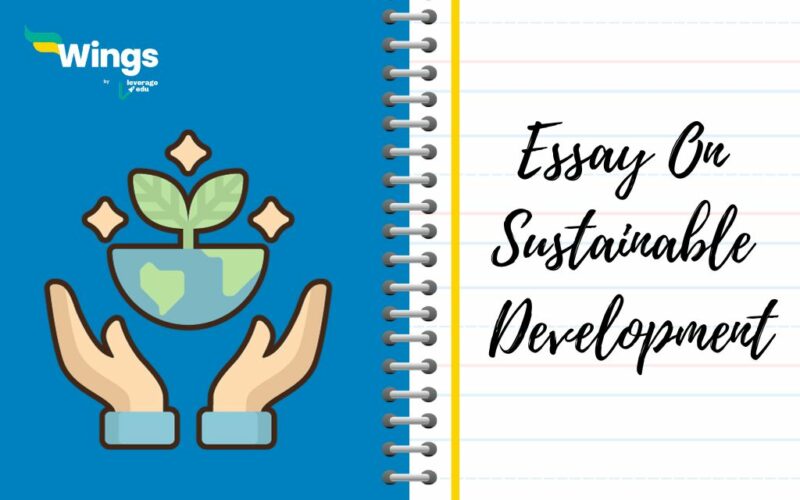
On 3rd August 2023, the Indian Government released its Net zero emissions target policy to reduce its carbon footprints. To achieve the sustainable development goals (SDG) , as specified by the UN, India is determined for its long-term low-carbon development strategy. Selfishly pursuing modernization, humans have frequently compromised with the requirements of a more sustainable environment.
As a result, the increased environmental depletion is evident with the prevalence of deforestation, pollution, greenhouse gases, climate change etc. To combat these challenges, the Ministry of Environment, Forest and Climate Change launched the National Clean Air Programme (NCAP) in 2019. The objective was to improve air quality in 131 cities in 24 States/UTs by engaging multiple stakeholders.
‘Development is not real until and unless it is sustainable development.’ – Ban Ki-Moon
The concept of Sustainable Development in India has even greater relevance due to the controversy surrounding the big dams and mega projects and related long-term growth. Since it is quite a frequently asked topic in school tests as well as competitive exams , we are here to help you understand what this concept means as well as the mantras to drafting a well-written essay on Sustainable Development with format and examples.
What is Sustainable Development?
As the term simply explains, Sustainable Development aims to bring a balance between meeting the requirements of what the present demands while not overlooking the needs of future generations. It acknowledges nature’s requirements along with the human’s aim to work towards the development of different aspects of the world. It aims to efficiently utilise resources while also meticulously planning the accomplishment of immediate as well as long-term goals for human beings, the planet as well and future generations. In the present time, the need for Sustainable Development is not only for the survival of mankind but also for its future protection.
Looking for ideas to incorporate in your Essay on Sustainable Development? Read our blog on Energy Management – Find Your Sustainable Career Path and find out!
250-300 Words Essay on Sustainable Development
To give you an idea of the way to deliver a well-written essay, we have curated a sample on sustainable development below, with 250-300 words:
300 Words Essay on Sustainable Development
To give you an idea of the way to deliver a well-written essay, we have curated a sample on sustainable development below, with 300 + words:

Must Read: Article Writing
500 Words Essay on Sustainable Development
To give you an idea of the way to deliver a well-written essay, we have curated a sample on sustainable development below, with 500 + words:

Essay Format
Before drafting an essay on Sustainable Development, students need to get familiarised with the format of essay writing, to know how to structure the essay on a given topic. Take a look at the following pointers which elaborate upon the format of a 300-350 word essay.
Introduction (50-60 words) In the introduction, students must introduce or provide an overview of the given topic, i.e. highlighting and adding recent instances and questions related to sustainable development. Body of Content (100-150 words) The area of the content after the introduction can be explained in detail about why sustainable development is important, its objectives and highlighting the efforts made by the government and various institutions towards it. Conclusion (30-40 words) In the essay on Sustainable Development, you must add a conclusion wrapping up the content in about 2-3 lines, either with an optimistic touch to it or just summarizing what has been talked about above.
Introduction
How to write the introduction of a sustainable development essay? To begin with your essay on sustainable development, you must mention the following points:
- What is sustainable development?
- What does sustainable development focus on?
- Why is it useful for the environment?
Conclusion of Sustainable Development Essay
How to write the conclusion of a sustainable development essay? To conclude your essay on sustainable development, mention why it has become the need of the hour. Wrap up all the key points you have mentioned in your essay and provide some important suggestions to implement sustainable development.
Importance of Sustainable Development
The importance of sustainable development is that it meets the needs of the present generations without compromising on the needs of the coming future generations. Sustainable development teaches us to use our resources in the correct manner. Listed below are some points which tell us the importance of sustainable development.
- Focuses on Sustainable Agricultural Methods – Sustainable development is important because it takes care of the needs of future generations and makes sure that the increasing population does not put a burden on Mother Earth. It promotes agricultural techniques such as crop rotation and effective seeding techniques.
- Manages Stabilizing the Climate – We are facing the problem of climate change due to the excessive use of fossil fuels and the killing of the natural habitat of animals. Sustainable development plays a major role in preventing climate change by developing practices that are sustainable. It promotes reducing the use of fossil fuels which release greenhouse gases that destroy the atmosphere.
- Provides Important Human Needs – Sustainable development promotes the idea of saving for future generations and making sure that resources are allocated to everybody. It is based on the principle of developing an infrastructure that is can be sustained for a long period of time.
- Sustain Biodiversity – If the process of sustainable development is followed, the home and habitat of all other living animals will not be depleted. As sustainable development focuses on preserving the ecosystem it automatically helps in sustaining and preserving biodiversity.
- Financial Stability – As sustainable development promises steady development the economies of countries can become stronger by using renewable sources of energy as compared to using fossil fuels, of which there is only a particular amount on our planet.
Examples of Sustainable Development
Mentioned below are some important examples of sustainable development. Have a look:
- Wind Energy – Wind energy is an easily available resource. It is also a free resource. It is a renewable source of energy and the energy which can be produced by harnessing the power of wind will be beneficial for everyone. Windmills can produce energy which can be used to our benefit. It can be a helpful source of reducing the cost of grid power and is a fine example of sustainable development.
- Solar Energy – Solar energy is also a source of energy which is readily available and there is no limit to it. Solar energy is being used to replace and do many things which were first being done by using non-renewable sources of energy. Solar water heaters are a good example. It is cost-effective and sustainable at the same time.
- Crop Rotation – To increase the potential of growth of gardening land, crop rotation is an ideal and sustainable way. It is rid of any chemicals and reduces the chances of disease in the soil. This form of sustainable development is beneficial to both commercial farmers and home gardeners.
- Efficient Water Fixtures – The installation of hand and head showers in our toilets which are efficient and do not waste or leak water is a method of conserving water. Water is essential for us and conserving every drop is important. Spending less time under the shower is also a way of sustainable development and conserving water.
- Sustainable Forestry – This is an amazing way of sustainable development where the timber trees that are cut by factories are replaced by another tree. A new tree is planted in place of the one which was cut down. This way, soil erosion is prevented and we have hope of having a better, greener future.
Related Articles
The Sustainable Development Goals (SDGs) are a set of 17 global goals established by the United Nations in 2015. These include: No Poverty Zero Hunger Good Health and Well-being Quality Education Gender Equality Clean Water and Sanitation Affordable and Clean Energy Decent Work and Economic Growth Industry, Innovation, and Infrastructure Reduced Inequality Sustainable Cities and Communities Responsible Consumption and Production Climate Action Life Below Water Life on Land Peace, Justice, and Strong Institutions Partnerships for the Goals
The SDGs are designed to address a wide range of global challenges, such as eradicating extreme poverty globally, achieving food security, focusing on promoting good health and well-being, inclusive and equitable quality education, etc.
India is ranked #111 in the Sustainable Development Goal Index 2023 with a score of 63.45.
Hence, we hope that this blog helped you understand the key features of an essay on sustainable development. If you are interested in Environmental studies and planning to pursue sustainable tourism courses , take the assistance of Leverage Edu ’s AI-based tool to browse through a plethora of programs available in this specialised field across the globe and find the best course and university combination that fits your interests, preferences and aspirations. Call us immediately at 1800 57 2000 for a free 30-minute counselling session
Team Leverage Edu
Leave a Reply Cancel reply
Save my name, email, and website in this browser for the next time I comment.
Contact no. *
Thanks a lot for this important essay.
NICELY AND WRITTEN WITH CLARITY TO CONCEIVE THE CONCEPTS BEHIND SUSTAINABLE DEVELOPMENT IN SCIENCE AND TECHNOLOGY.
Thankyou so much!

Leaving already?
8 Universities with higher ROI than IITs and IIMs
Grab this one-time opportunity to download this ebook
Connect With Us
25,000+ students realised their study abroad dream with us. take the first step today..

Resend OTP in

Need help with?
Study abroad.
UK, Canada, US & More
IELTS, GRE, GMAT & More
Scholarship, Loans & Forex
Country Preference
New Zealand
Which English test are you planning to take?
Which academic test are you planning to take.
Not Sure yet
When are you planning to take the exam?
Already booked my exam slot
Within 2 Months
Want to learn about the test
Which Degree do you wish to pursue?
When do you want to start studying abroad.
September 2024
January 2025
What is your budget to study abroad?

How would you describe this article ?
Please rate this article
We would like to hear more.
Essay On Sustainable Development
500 words essay on sustainable development.
Sustainable development is basically an action plan which helps us to achieve sustainability in any activity which makes use of the resource. Moreover, it also demands immediate and intergenerational replication. Through essay on sustainable development, we will help you understand the concept and its advantages.
Through sustainable development, we formulate organising principles which help to sustain the limited resources essential to provide for the needs of our future generations. As a result, they will be able to lead a content life on the planet .

What is Sustainable Development?
The World Commission on Environment and Development popularized this concept in 1987. Their report defines the idea as a “development which meets the needs of the present without compromising the ability of future generations to meet their needs.”
In other words, they aimed to prevent the stripping the natural world of resources which the future generations will require. As we all know that usually, one particular need drives development. Consequently, the wider future impacts are not considered.
As a result, a lot of damage happens due to this type of approach. Thus, the longer we continue to pursue unsustainable development, the more severe will the consequences be. One of the most common is climate change which is being debated widely worldwide.
In fact, climate change is already wreaking havoc on our surroundings. So, the need of the hour is sustainable development. We must ask ourselves, must we leave a scorched planet with an ailing environment for our future generations?
In order to undo the mess created by us, we must follow sustainable development. This will help us promote a more social, environmental and economical thinking. Most importantly, it is not that difficult to attain this.
We must see that world as a system which connects space, and time. Basically, it helps you understand that water pollution in South Africa will ultimately impact water quality in India. Similarly, it is the case for other things as well.
Get the huge list of more than 500 Essay Topics and Ideas
Measures to Practice Sustainable Development
There are many measures to take up for practising sustainable development. To begin with, it is important to ensure clean and hygienic living and working conditions for the people.
Next, sponsoring research on environmental issues which pertains to regions. Further, ensuring safety against known and proven industrial hazards. It is also important to find economical methods to salvage dangerous industrial wastes.
Most importantly, we must encourage afforestation . Including environmental education as part of the school and college curriculum will also help. Similarly, it is essential to socialize and humanize all environmental issues.
Further, we must encourage uses of non-conventional sources of energy, especially solar energy. Looking for substitutes for proven dangerous materials on the basis of local resources and needs will help. Likewise, we must produce environment-friendly products.
It is also essential to popularize the use of organic fertilizers and other biotechniques. Finally, the key is environmental management which must be monitored and ensure accountability.
Conclusion of Essay on Sustainable Development
To sum it up, sustainable development continuously seeks to achieve social and economic progress in ways which will not exhaust the Earth’s finite natural resources. Thus, we must all develop ways to meet these needs so that our future generations can inherit a healthier and greener planet.
FAQ on Essay on Sustainable Development
Question 1: State two measures we can take for sustainable development.
Answer 1: The first measure we can take is by finding economical methods for salvaging hazardous industrial wastes. Next, we must encourage afforestation.
Question 2: What is the aim of sustainable development?
Answer 2 : The aim of sustainable development is to maximise human well-being or quality of life without having to risk the life support system.
Customize your course in 30 seconds
Which class are you in.

- Travelling Essay
- Picnic Essay
- Our Country Essay
- My Parents Essay
- Essay on Favourite Personality
- Essay on Memorable Day of My Life
- Essay on Knowledge is Power
- Essay on Gurpurab
- Essay on My Favourite Season
- Essay on Types of Sports
Leave a Reply Cancel reply
Your email address will not be published. Required fields are marked *
Download the App

Sustainable Development Essay
500+ words essay on sustainable development.
Sustainable development is a central concept. It is a way of understanding the world and a method for solving global problems. The world population continues to rise rapidly. This increasing population needs basic essential things for their survival such as food, safe water, health care and shelter. This is where the concept of sustainable development comes into play. Sustainable development means meeting the needs of people without compromising the ability of future generations. In this essay on sustainable development, students will understand what sustainable development means and how we can practise sustainable development. Students can also access the list of CBSE essay topics to practise more essays.
What Does Sustainable Development Means?
The term “Sustainable Development” is defined as the development that meets the needs of the present generation without excessive use or abuse of natural resources so that they can be preserved for the next generation. There are three aims of sustainable development; first, the “Economic” which will help to attain balanced growth, second, the “Environment”, to preserve the ecosystem, and third, “Society” which will guarantee equal access to resources to all human beings. The key principle of sustainable development is the integration of environmental, social, and economic concerns into all aspects of decision-making.
Need for Sustainable Development?
There are several challenges that need attention in the arena of economic development and environmental depletion. Hence the idea of sustainable development is essential to address these issues. The need for sustainable development arises to curb or prevent environmental degradation. It will check the overexploitation and wastage of natural resources. It will help in finding alternative sources to regenerate renewable energy resources. It ensures a safer human life and a safer future for the next generation.
The COVID-19 pandemic has underscored the need to keep sustainable development at the very core of any development strategy. The pandemic has challenged the health infrastructure, adversely impacted livelihoods and exacerbated the inequality in the food and nutritional availability in the country. The immediate impact of the COVID-19 pandemic enabled the country to focus on sustainable development. In these difficult times, several reform measures have been taken by the Government. The State Governments also responded with several measures to support those affected by the pandemic through various initiatives and reliefs to fight against this pandemic.
How to Practise Sustainable Development?
The concept of sustainable development was born to address the growing and changing environmental challenges that our planet is facing. In order to do this, awareness must be spread among the people with the help of many campaigns and social activities. People can adopt a sustainable lifestyle by taking care of a few things such as switching off the lights when not in use; thus, they save electricity. People must use public transport as it will reduce greenhouse gas emissions and air pollution. They should save water and not waste food. They build a habit of using eco-friendly products. They should minimise waste generation by adapting to the principle of the 4 R’s which stands for refuse, reduce, reuse and recycle.
The concept of sustainable development must be included in the education system so that students get aware of it and start practising a sustainable lifestyle. With the help of empowered youth and local communities, many educational institutions should be opened to educate people about sustainable development. Thus, adapting to a sustainable lifestyle will help to save our Earth for future generations. Moreover, the Government of India has taken a number of initiatives on both mitigation and adaptation strategies with an emphasis on clean and efficient energy systems; resilient urban infrastructure; water conservation & preservation; safe, smart & sustainable green transportation networks; planned afforestation etc. The Government has also supported various sectors such as agriculture, forestry, coastal and low-lying systems and disaster management.
Students must have found this essay on sustainable development useful for practising their essay writing skills. They can get the study material and the latest updates on CBSE/ICSE/State Board/Competitive Exams, at BYJU’S.
Frequently Asked Questions on Sustainable development Essay
Why is sustainable development a hot topic for discussion.
Environment change and constant usage of renewable energy have become a concern for all of us around the globe. Sustainable development must be inculcated in young adults so that they make the Earth a better place.
What will happen if we do not practise sustainable development?
Landfills with waste products will increase and thereby there will be no space and land for humans and other species/organisms to thrive on.
What are the advantages of sustainable development?
Sustainable development helps secure a proper lifestyle for future generations. It reduces various kinds of pollution on Earth and ensures economic growth and development.
Leave a Comment Cancel reply
Your Mobile number and Email id will not be published. Required fields are marked *
Request OTP on Voice Call
Post My Comment
- Share Share
Register with BYJU'S & Download Free PDFs
Register with byju's & watch live videos.

Counselling
Sustainable Development Goals
The Sustainable Development Goals were adopted by the United Nations in 2015 as a call-to-action for people worldwide to address five critical areas of importance by 2030: people, planet, prosperity, peace, and partnership.
Biology, Health, Conservation, Geography, Human Geography, Social Studies, Civics
Set forward by the United Nations (UN) in 2015, the Sustainable Development Goals (SDG) are a collection of 17 global goals aimed at improving the planet and the quality of human life around the world by the year 2030.
Image courtesy of the United Nations
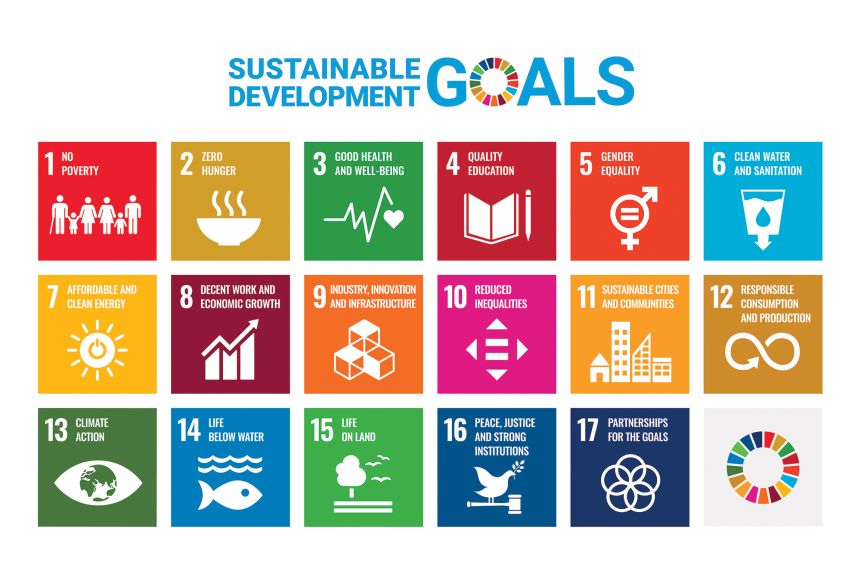
In 2015, the 193 countries that make up the United Nations (UN) agreed to adopt the 2030 Agenda for Sustainable Development. The historic agenda lays out 17 Sustainable Development Goals (SDGs) and targets for dignity, peace, and prosperity for the planet and humankind, to be completed by the year 2030. The agenda targets multiple areas for action, such as poverty and sanitation , and plans to build up local economies while addressing people's social needs.
In short, the 17 SDGs are:
Goal 1: No Poverty: End poverty in all its forms everywhere.
Goal 2: Zero Hunger: End hunger, achieve food security and improved nutrition and promote sustainable agriculture.
Goal 3: Good Health and Well-being: Ensure healthy lives and promote well-being for all at all ages.
Goal 4: Quality Education: Ensure inclusive and equitable quality education and promote lifelong learning opportunities for all.
Goal 5: Gender Equality : Achieve gender equality and empower all women and girls.
Goal 6: Clean Water and Sanitation: Ensure availability and sustainable management of water and sanitation for all.
Goal 7: Affordable and Clean Energy: Ensure access to affordable, reliable, sustainable and modern energy for all.
Goal 8: Decent Work and Economic Growth: Promote sustained, inclusive and sustainable economic growth, full and productive employment and decent work for all.
Goal 9: Industry, Innovation, and Infrastructure: Build resilient infrastructure, promote inclusive and sustainable industrialization, and foster innovation.
Goal 10: Reduced Inequality : Reduce in equality within and among countries.
Goal 11: Sustainable Cities and Communities: Make cities and human settlements inclusive, safe, resilient, and sustainable.
Goal 12: Responsible Consumption and Production: Ensure sustainable consumption and production patterns.
Goal 13: Climate Action: Take urgent action to combat climate change and its impacts.
Goal 14: Life Below Water: Conserve and sustainably use the oceans, seas, and marine resources for sustainable development.
Goal 15: Life on Land: Protect, restore, and promote sustainable use of terrestrial ecosystems, sustainably manage forests, combat desertification, and halt and reverse land degradation and halt biodiversity loss.
Goal 16: Peace, Justice , and Strong Institutions: Promote peaceful and inclusive societies for sustainable development, provide access to justice for all and build effective, accountable, and inclusive institutions at all levels.
Goal 17: Partnerships to Achieve the Goal: Strengthen the means of implementation and revitalize the global partnership for sustainable development.
The SDGs build on over a decade of work by participating countries. In essence, the SDGs are a continuation of the eight Millennium Development Goals (MDGs), which began in the year 2000 and ended in 2015. The MDGs helped to lift nearly one billion people out of extreme poverty, combat hunger, and allow more girls to attend school. The MDGs, specifically goal seven, helped to protect the planet by practically eliminating global consumption of ozone-depleting substances; planting trees to offset the loss of forests; and increasing the percent of total land and coastal marine areas worldwide. The SDGs carry on the momentum generated by the MDGs with an ambitious post-2015 development agenda that may cost over $4 trillion each year. The SDGs were a result of the 2012 Rio+20 Earth Summit, which demanded the creation of an open working group to develop a draft agenda for 2015 and onward.
Unlike the MDGs, which relied exclusively on funding from governments and nonprofit organizations, the SDGs also rely on the private business sector to make contributions that change impractical and unsustainable consumption and production patterns. Novozymes, a purported world leader in biological solutions, is just one example of a business that has aligned its goals with the SDGs. Novozymes has prioritized development of technology that reduces the amount of water required for waste treatment. However, the UN must find more ways to meaningfully engage the private sector to reach the goals, and more businesses need to step up to the plate to address these goals.
Overall, limited progress has been made with the SDGs. According to the UN, many people are living healthier lives now compared to the start of the millennium, representing one area of progress made by the MDGs and SDGs. For example, the UN reported that between 2012 and 2017, 80 percent of live births worldwide had assistance from a skilled health professional—an improvement from 62 percent between 2000 and 2005.
While some progress has been made, representatives who attended sustainable development meetings claimed that the SDGs are not being accomplished at the speed, or with the appropriate momentum, needed to meet the 2030 deadline. On some measures of poverty, only slight improvements have been made: The 2018 SDGs Report states that 9.2 percent of the world's workers who live with family members made less than $1.90 per person per day in 2017, representing less than a 1 percent improvement from 2015. Another issue is the recent rise in world hunger. Rates had been steadily declining, but the 2018 SDGs Report stated that over 800 million people were undernourished worldwide in 2016, which is up from 777 million people in 2015.
Another area of the SDGs that lacks progress is gender equality. Multiple news outlets have recently reported that no country is on track to achieve gender equality by 2030 based on the SDG gender index. On a scale of zero to 100, where a score of 100 means equality has been achieved, Denmark was the top performing country out of 129 countries with score slightly under 90. A score of 90 or above means a country is making excellent progress in achieving the goals, and 59 or less is considered poor headway. Countries were scored against SDGs targets that particularly affect women, such as access to safe water or the Internet. The majority of the top 20 countries with a good ranking were European countries, while sub-Saharan Africa had some of the lowest-ranking countries. The overall average score of all countries is a poor score of 65.7.
In fall of 2019, heads of state and government will convene at the United Nations Headquarters in New York to assess the progress in the 17 SDGs. The following year—2020—marks the deadline for 21 of the 169 SDG targets. At this time, UN member states will meet to make a decision to update these targets.
In addition to global efforts to achieve the SDGs, according to the UN, there are ways that an individual can contribute to progress: save on electricity while home by unplugging appliances when not in use; go online and opt in for paperless statements instead of having bills mailed to the house; and report bullying online when seen in a chat room or on social media.
Media Credits
The audio, illustrations, photos, and videos are credited beneath the media asset, except for promotional images, which generally link to another page that contains the media credit. The Rights Holder for media is the person or group credited.
Production Managers
Program specialists, last updated.
October 19, 2023
User Permissions
For information on user permissions, please read our Terms of Service. If you have questions about how to cite anything on our website in your project or classroom presentation, please contact your teacher. They will best know the preferred format. When you reach out to them, you will need the page title, URL, and the date you accessed the resource.
If a media asset is downloadable, a download button appears in the corner of the media viewer. If no button appears, you cannot download or save the media.
Text on this page is printable and can be used according to our Terms of Service .
Interactives
Any interactives on this page can only be played while you are visiting our website. You cannot download interactives.
Related Resources

Want to create or adapt books like this? Learn more about how Pressbooks supports open publishing practices.
Introduction of Sustainability, Sustainable Development, and the Sustainable Development Goals (SDGs)
What is sustainability.
Sustainability is a well-known and frequently used term of the 21st century. How often do you see or hear the word? Have you ever stopped to really think about what exactly does sustainability mean and where did the term originate from?
A quick Google search for ‘what is sustainability’ yields over 1.9 billion results. Sustainability is widely defined as ‘the ability to be maintained at a certain rate or level’. Embedded in most definitions of sustainability are concerns for the environment, social equity, and economic prosperity(1). Most definitions look to avoid the depletion of natural resources to maintain an ecological balance. Sustainability in the context of the environment looks at the activities required to balance social, economic, and environmental needs to maintain ecosystem services at a suitable level. It is generally accepted, the goals of sustainability are related to the need for the conservation of natural capital and ecosystem services, with a shift to a less resource-intensive future [1] .
While to most, the concept of sustainability is a relatively new idea, sustainability has a long history of use and meaning. The practice of sustainability has been utilized by various cultures for thousands of years, with the term sustainability first used in the 1700’s. Sustainability comes from the practice of nachhaltigkeit , translated to mean ‘sustained yield’ in English, a term coined in 1713 by German foresters [2] . Sustained yield refers to the practice of taking only enough trees to allow forests to naturally regenerate well into the future. The concept of sustained yield broadened to include the conservation of plants, animals, and other food necessities, eventually moving beyond the forestry discourse but still mainly confined to research and science.
It was not until the 1970’s that the concept of sustainability became more widely used. In January 1972, the journal the Ecologist published the Blueprint for Survival , a series of science papers calling for better management of natural resources and modification of consumptive lifestyles of western civilizations. That same year, a global think-tank published the report Limits to Growth , where a definition was given to the term sustainable. For the first time in the literature, sustainable was defined to mean without sudden and uncontrolled collapse and capable of satisfying the basic material requirements of all its people (2). Then later that year the United Nations (UN) world conference on human environment was held Stockholm, Sweden to address the global the growing environmental crisis. The term sustainable development was introduced into the discourse. As evidenced at the UN Conference, the environment was being neglected and not in balance with economic development.
Through the 1980’s, the concept of sustainability became more mainstream. In 1987, former Norwegian Prime Minister Gro Harlem Brundtland, as chairwoman of what was then the World Commission on Environment and Development (WCED) released a Report, widely known as the Brundtland’s Commission, Our Common Future . The report emphasized the importance that development should consider social, environmental, and economic aspects to ensure the sustainability of all human societies. Her main concern was that development had to meet “the needs of the present without compromising the ability of future generations to meet their own needs” [3] . This concept went on to become the most widely used definition of sustainability although in the context of sustainable development.
Although sustainability and sustainable development both consider the environment, society, and economies with a future timeframe, the two terms have very different meanings and should not be used interchangeably. Sustainability looks at the activities required to protect the environment as our base for survival while balancing social, cultural, and economic needs. It is generally accepted that the goals of sustainability are related to the need to conserve our natural world with a shift away from the resource-intensive current way of living 1 .
What is Sustainable Development?
We learned that sustainability is the process of living within the limits of available physical, natural, and social resources in ways that allow all living things, not only humans to thrive well into the future.
Sustainable development is a process that creates growth and progress through the addition of physical, economic, environmental, and social components to improve quality of life without damaging the resources of the environment. Simply put, sustainable development is a way for people to use resources without the resources running out 3 .
As previously discussed, the concept of sustainable development arrived in 1987 by the Brundtland Commission “Our Common Future”, the document that defined sustainable development as an approach designed to meet the needs of the present [generation] without compromising the ability of future generations to meet their own needs 3 . This definition incorporated the understanding that economic growth is required to provide societies with the necessities of life such as clean water and food, while acknowledging the dilemma of environmental degradation that often coincides with economic development.
In 1992 the UN conference on the environment and development, informally known as the Earth Summit, or the Rio Conference took place in Rio de Janeiro, Brazil. The conference promoted the idea of ecological sustainable development and in order to achieve it you had to consider social development (communities). From the mid 1990’s, different strategies were developed to try to work out what sustainability means in practice, how do we get that middle area where the environment, economics, and social development are achieved at the same time. Governments alone can not achieve sustainable development. Governments can set regulations and determine infrastructure needs but they don’t tend to have long-term goals in mind, they tend to focus on election cycles which are typically about 4 to 8 years. The market economies (goods and services) timeframe is usually only about 4 months to a year. Sustainability is about long-term solutions. The market economies and governments can not effectively do this. If the community is not driving the will for a better more sustainable future, sustainable development will be difficult to achieve. As we previously discussed, the Brundtland Commission’s definition has become a widely used definition for sustainable development and sustainability and has therefore come with many challenges, including confusion over meaning, interpretations, and misinformation.
Recognizing some of the key challenges with the implementation of sustainable development and the quest for achieving a balance between the environment and economies, the role of people and societies were formally added into the equation for sustainable development in 2005 at the UN World Summit on Social Development. The three pillars of sustainability became widely known and currently used today:
(Click on the “?” icons below for more information):
This updated model for sustainable development recognizes that in order to meet the needs of current and future generations you have to consider the three pillars or the 3P’s (people, planet, prosperity), and they all need to be working together at the same. The key being all at the same time, or simultaneously.
Integrating the short-term and long-term needs with a focus on future generations, will require social development, environmental protection, and economic prosperity working in unison. Being able to incorporate sustainability into your day to day activities, this is what will create change.
The United Nations and the Path to the Sustainable Development Goals (SDGs)
History of the un.
Direct Source
The United Nations is an international organization founded in 1945 after the Second World War by 51 countries committed to maintaining international peace and security, developing friendly relations among nations, and promoting social progress, better living standards and human rights.
Due to its unique international character, and the powers vested in its founding Charter, the Organization can take action on a wide range of issues and provide a forum for its 193 Member States to express their views, through the General Assembly, the Security Council, the Economic and Social Council and other bodies and committees.
The work of the United Nations reaches every corner of the globe. Although best known for peacekeeping, peace-building, conflict prevention and humanitarian assistance, there are many other ways the United Nations and its System (specialized agencies, funds, and programmes) affect our lives and make the world a better place. The Organization works on a broad range of fundamental issues, from sustainable development, environment and refugees protection, disaster relief, counter terrorism, disarmament and non-proliferation, to promoting democracy, human rights, gender equality and the advancement of women, governance, economic and social development and international health, clearing landmines, expanding food production, and more, in order to achieve its goals and coordinate efforts for a safer world for this and future generations.
The UN has 4 main purposes:
- To keep peace throughout the world;
- To develop friendly relations among nations;
- To help nations work together to improve the lives of poor people, to conquer hunger, disease, and illiteracy, and to encourage respect for each other’s rights and freedoms;
- To be a centre for harmonizing the actions of nations to achieve these goals
Pathway to the Sustainable Development Goals (SDGs)
In 2015, the 2030 Agenda for Sustainable Development was adopted by 193 United Nations (UN) Member States. The 2030 Agenda is centered on the 17 SDGs which are underpinned by the Millennium Development Goals (MDGs). The MDGs were developed in 2000 to end poverty and hunger, fight inequality and injustice, advance climate change action, create sustainable consumption and production, and promote peace and prosperity for all. One major change between the MDGs versus the SDGs is that for the SDGs, all countries are now involved. The MDGs only applied to developing countries. Another difference is that each country has set their own goals and priorities for achieving the SDGs. International collaboration to advance the SDG Agenda remains a critical component. The 17 SD goals, with their 169 targets, and over 230 indicators work together at the local and international level to help promote a shared global framework to achieve a fair, equitable, and sustainable future for all. Currently, all countries and international organizations are working on the achievement of the UN 2030 Agenda serving as the basis for better economic development that is environmentally low impact, socially just, and economically efficient and fair.
Pathway to the SDGs
Comprehension Questions
Recommended reading.
- Sustainable Development Solutions Network. (2021). Sustainable Development Report 2021: The Decade of Action for the Sustainable Development Goals .
Additional Readings
- Brundtland G, Khalid M. 1987. UN Brundtland commission report. Our Common Future . 41-59.
- Kidd C. V. 1992. The evolution of sustainability . Journal of Agricultural and Environmental Ethics , 5(1), 1-26.
- Baker, J., Dupont, D., & Vasseur, L. (2021). Exploring Canadian Ramsar Sites Ecosystem Governance and Sustainability. Wetlands, 41(1), 1-11. ↵
- Grober, U. (2007). Deep roots-a conceptual history of sustainable development (Nachhaltigkeit) . ↵
- United Nations. (2021). 1987 Report of the World Commission on Environment and Development: Our Common Future (page 41) . ↵
Introduction to the Sustainable Development Goals (SDGs) Copyright © by Jocelyn Baker is licensed under a Creative Commons Attribution 4.0 International License , except where otherwise noted.
Share This Book
- Get involved
Discussion Paper - Governance for Sustainable Development
October 29, 2015.
There are now widely accepted arguments that governance is of high relevance to the post-2015 development agenda: effective governance institutions and systems that are responsive to public needs deliver essential services and promote inclusive growth, while inclusive political processes ensure citizens can hold public officials to account. In addition, good governance promotes freedom from violence, fear and crime, and helps build peaceful and secure societies with the stability needed to attract and sustain development investments. A consensus is emerging to accept divergence in the way countries develop and improve their systems of governance, while reaffirming the global norms and standards agreed upon by member states. In practice, improving governance requires action in a wide range of areas, not all of which can be addressed at once, and not all can be subject of a global consensus. The challenge in integrating governance into the post-2015 development framework is to translate experience and evidence from multiple and diverse governance systems into concrete, measurable and broadly acceptable global development goals and targets.
The UNDP Discussion Paper on 'Governance for Sustainable Development' provides an overview of the challenges and opportunities that evolve from the ongoing discussions on how best to integrate governance, rule of law, peace and security priorities into the post-2015 development agenda, and lays out the case for why different aspects of governance, peace and security matter for a universal sustainable development agenda.. From the discussions in the Open Working Group, several broad options are emerging, which are not mutually exclusive: stand-alone goals on governance, rule of law and peaceful and stable societies; and governance as an enabler that is referenced in accompanying text, and is "mainstreamed" across other targets. This paper furthers this discussion with a contributive analysis of these options and their strengths and weaknesses. The paper finally reflects on the challenge of measuring progress.
Document Type
Related publications, publications, 2024 lgbti inclusion index: report on the pilot implement....
This report could be useful for statisticians, national human rights institutions, policymakers, researchers and activists. It elaborates on the key findings an...

HIV and Health Annual Report 2022-2023 | Halfway to 2030:...
The HIV and Health Annual Report showcases the progress made in the face of profound global turbulence at the halfway mark to Agenda 2030.
How Likely Are We to Achieve the SDGs at the Current Pace...
This policy brief analyses the possible convergence of SDG indicators for Colombia.
New Effective Paths for Approaching the 2030 Agenda with ...
This policy brief describes the process of challenges and knowledge gained from implementing and adjusting the SDG PUSH methodology to prioritize public policy ...
No Soft Landing for Developing Economies
Many developing economies are stuck in a negative debt-development feedback loop keeping them from undertaking new growth- and welfare-enhancing investments. Fo...
A Shared Vision for Digital Technology and Governance: Th...
This paper documents these benefits and risks and argues for effective governance of digital technologies to mitigate these challenges.
Thank you for visiting nature.com. You are using a browser version with limited support for CSS. To obtain the best experience, we recommend you use a more up to date browser (or turn off compatibility mode in Internet Explorer). In the meantime, to ensure continued support, we are displaying the site without styles and JavaScript.
- View all journals
- My Account Login
- Explore content
- About the journal
- Publish with us
- Sign up for alerts
- Open access
- Published: 12 November 2019
Sustainable Development Goals (SDGs): Are we successful in turning trade-offs into synergies?
- Christian Kroll ORCID: orcid.org/0000-0001-9954-6123 1 ,
- Anne Warchold 2 &
- Prajal Pradhan ORCID: orcid.org/0000-0003-0491-5489 2
Palgrave Communications volume 5 , Article number: 140 ( 2019 ) Cite this article
96k Accesses
309 Citations
66 Altmetric
Metrics details
- Development studies
- Environmental studies
The Agenda 2030 with its 17 Sustainable Development Goals (SDGs) provides the framework that all United Nations (UN) member states have pledged to fulfill. The achievement of this agenda crucially depends on whether humankind will be able to maximize synergies and resolve existing trade-offs between the SDGs. We provide the first analysis of future interactions for projected SDG trends until 2030 within and between goals, and we analyze how trade-offs and synergies have evolved in the recent past globally. For certain goals, we find positive developments with notable synergies in our projections, especially for SDGs 1, 3, 7, 8, and 9: Poverty alleviation and strengthening the economy, rooted in innovation, and modern infrastructure, therefore continue to be the basis upon which many of the other SDGs can be achieved. However, especially SDGs 11, 13, 14, 16, and 17 will continue to have notable trade-offs, as well as non-associations with the other goals in the future, which emphasizes the need to foster innovations and policies that can make our cities and communities more sustainable, as well as strengthen institutions and spur climate action. We show examples of a successful transformation of trade-offs into synergies that should be emulated in other areas to create a virtuous cycle of SDG progress. The alarming inability to overcome certain persistent trade-offs we have found, and indeed the deterioration for some SDGs, can seriously threaten the achievement of the Agenda 2030.
Similar content being viewed by others
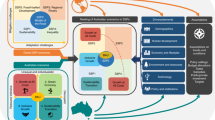
Greater gains for Australia by tackling all SDGs but the last steps will be the most challenging
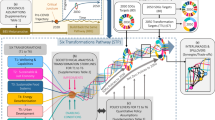
Modelling six sustainable development transformations in Australia and their accelerators, impediments, enablers, and interlinkages
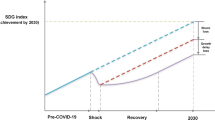
Progress towards the Sustainable Development Goals has been slowed by indirect effects of the COVID-19 pandemic
Introduction.
The Agenda 2030 with its 17 Sustainable Development Goals (SDGs) provides the framework that all 193 United Nations (UN) member states have pledged to achieve (United Nations, 2015 ). Unlike previous development agendas that put an emphasis on economic growth, the SDGs are a universal framework that contains many potentially diverging policy goals in the economic, social, and environmental sphere, while some goals are thought to be mutually supportive. The achievement of the agenda crucially depends on whether we will be able to maximize such synergies and resolve the existing trade-offs.
To shed light onto this important topic, research is beginning to examine the interlinkages between the 17 goals (Lu et al., 2015 ; Schmidt et al., 2015 ; Pradhan, 2019 ; Breuer et al., 2019 ). Previous studies prior to the SDGs had already looked at interlinkages, for instance, between climate change adaptation and mitigation response (Smith and Olesen, 2010 ); poverty alleviation (Mathy and Blanchard, 2016 ); meeting the Millennium Development Goals (MDGs) (Bue and Klasen, 2013 ); and balancing economic development, environmental sustainability, and social inclusion for human well-being (Ibisch et al., 2016 ; Sachs, 2012 ). With the SDGs, however, a new level of opportunities for classifying interactions has emerged so that these issues can be examined more systematically in the future (Costanza et al., 2016 ; Rickels et al., 2016 ; Nilsson et al., 2016 ). The first complete quantification of synergies and trade-offs within and across the SDGs was provided by Pradhan et al. ( 2017 ). It was found that SDG 1 ( No poverty ) has synergetic relationship with many goals, while SDG 12 ( Responsible consumption and production ) is associated with trade-offs, especially regarding economic progress. A similar pattern was found in a more recent study by Lusseau and Mancini ( 2019 ) who reported that “limiting climate change, reducing inequalities and responsible consumption are key hurdles to achieving 2030 goals across countries [while] […] poverty alleviation and reducing inequalities will have compound positive effects on all SDGs”. Modeling three alternative policy pathways (technology, lifestyle change, and decentralized governance) for achieving SDG targets, these alternative development paths lead to synergies that enhance target achievement, while others lead to trade-offs (Moyer and Bohl, 2019 ). Additional studies have highlighted selected aspects of SDG interactions, such as between energy (SDG 7) and other SDGs (Nerini et al., 2018 ), or between selected social and environmental goals (Scherer et al., 2018 ), or with a case study to facilitate the prioritization of SDG targets for 22 countries in the Arab region (Allen et al., 2019 ), or at the local level in Sweden for selected SDG interactions (Engström et al., 2019 ), or relating urban scaling with SDG 11 ( Sustainable cities and communities ) indicators (Akuraju et al., 2020 ).
Although such studies of a snapshot in time on interactions are helpful to assess the current state of the challenge, in the end the world community’s ability to achieve Agenda 2030 will crucially depend on whether over time trade-offs across the entire spectrum of the SDGs can be minimized and synergies can be maximized. Therefore, this study examines whether countries are currently good enough at dealing with these interlinkages based on extrapolated developments in the recent past in relation to the level needed for SDG achievement by 2030: How have interactions within and between the 17 SDGs across countries evolved over time? Are we successful in moving from trade-offs to synergies at the rate that is necessary to achieve the goals? We analyze how trade-offs and synergies between the goals have developed between 2010 and 2018. Most importantly, we provide the first analysis of future interactions for projected SDG trends until 2030. The most significant added value to the literature of our study is therefore that it fills a gap by being the first analysis to use SDG trends to calculate projected SDG interactions in the future. Given the increased focus in recent years on the need for synergies between economic, social, and environmental progress (in addition to the studies mentioned earlier in this section, see e.g. Stiglitz et al., 2009 , 2018 ), we hypothesize that synergies between these three spheres of progress will occupy a larger portion in our projections of the interlinkages until 2030 than trade-offs. Table 1 lists all SDGs and their full titles.
Data and method
The SDG Index and Dashboards database provides globally available data at country level on SDG indicators from 2010 to 2018 (Sachs et al., 2018 ). This is the first study on SDG interactions using the SDG Index and Dashboards report data which has been described as “the most comprehensive picture of national progress on the SDGs and offers a useful synthesis of what has been achieved so far” (Nature Sustainability Editorial, 2018 ). The database contains data for 193 countries with up to 111 indicators per country on all 17 SDGs (as of 14 May 2019; detailed information, including the full list of indicators and the raw data used here are available from www.sdgindex.org ; see also Schmidt-Traub et al., 2017 for the methodology). In order to avoid discussions associated with the aggregation of the goals into a single number (Diaz-Sarachaga et al., 2018 ), we do not use the aggregated SDG Index score in this paper but only scores for the separate goals.
Interactions can be classified as synergies (i.e. progress in one goal favors progress in another) or trade-offs (i.e. progress in one goal hinders progress in another). We examine synergies and trade-offs to the results of a Spearman correlation analysis across all the SDG indicators, accounting for all countries, and the entire time-frame between 2010 and 2018. We thereby analyze in the main analytical section (section “Interactions between SDGs”) up to 136 SDG pairs per year for 9 consecutive years minus 69 missing cases due to data gaps, resulting in a total of 1155 SDG interactions under study.
In a first analysis (section “Interactions within SDGs”), we examine interactions within each goal since every SDG is made up of a number of targets that are measured by various indicators. In a second analysis (section “Interactions between SDGs”), we then examine the existence of a significant positive and negative correlations in the SDG performance across countries. We conduct a series of cross-sectional analyses for the period 2010–2018 to understand how the SDG interactions have developed from year to year. We use correlation coefficient (rho value) ± 0.5 as the threshold to define synergy and trade-off between an indicator pair. An association is considered to have at least moderate relationship when the rho value is >0.5 or <−0.5 (Smarandache, 2009 ). The development on SDG interactions identified based on maximum change occurred in the shares of synergies, trade-offs, and no relations for SDG pairs between 2010 and 2018. All variables were re-coded in a consistent way towards SDG progress to avoid false associations, i.e. a positive sign is assigned for indicators with values that would have to increase for attaining the SDGs, and a negative sign in the opposite case. Our analysis is therefore applying a similar method as described by Pradhan et al. ( 2017 ) in so far as we are examining SDG interlinkages as synergies (positive correlation) and trade-offs (negative correlation). However, in important contrast to the aforementioned paper, we do not investigate SDG interactions within countries longitudinally, but instead we carry out cross-sectional investigations across countries on how the global community’s ability to manage synergies and trade-offs has evolved over the last 9 years, as well as projected SDG trends until 2030. We therefore examine global cross-sectional country data. An advance of such a global cross-sectional analysis is that it can compare the status of different countries at a given point in time, covering the SDG interactions over the whole range of development spectrum from least developed to developed ones. The longitudinal analysis covers only the interactions occurred within a country for the investigated period. Moreover, we repeat this global cross-sectional analysis for a number of consecutive years. Another novel contribution of this study is therefore to highlight how such global SDG interactions have evolved in the recent years. Finally, by resorting to the SDG Index database for the first time in the research field of SDG interactions, we use a more comprehensive dataset than was used in Pradhan et al. ( 2017 ).
In the last analytical section (“Interactions in the projected SDG trends until 2030”), we provide the first examination of how interlinkages between the projected trends in the SDGs will evolve until 2030. Based on SDG country performance from 2010 until 2015, Sachs et al. ( 2018 ) have calculated linear trajectories for the SDGs with respect to the level that will be required to achieve each goal by 2030. An important feature here is that the development in each country and goal from 2010 to 2015 up until the year 2030 is not only extrapolated but for the final score also set in relation to the level needed for SDG achievement by then. More precisely, all available data points between the years 2010 and 2015 were gathered by Sachs et al. ( 2018 ), and then their development over said period was extrapolated into the future. The linear annual growth rates (i.e. annual percentage improvements) needed to achieve each SDG by 2030 was compared to the actual average annual growth rate in each country and indicator over the period 2010–2015 (with some exceptions). The overall goal trends are an arithmetic average of the rescaled values for all trend indicators under the respective goal. This projection results in a five-point scale variable with the following classification: “decreasing” (country score is moving away from SDG achievement on this indicator), “stagnating” (country score remains stagnant or is improving at a rate below 50% of what is needed for SDG achievement by 2030), “moderately increasing” (country score is increasing at a rate above 50% but below the rate needed for SDG achievement by 2030, “on track” (score is improving at the rate needed for SDG achievement by 2030), “maintaining goal achievement” (country score is level and remains at or above SDG achievement). More details on the calculation method are available in Sachs et al. ( 2018 ). We perform the first analysis of future interactions for this new variable by assessing the synergies and trade-offs between future SDG achievement trends until 2030. Additionally, we investigate the projected SDG interactions for different income groups (low/middle/high-income countries as categorized by the World Bank) to identify similarities and differences among the income groups regarding future SDG achievement trends. In order to do so, as the first step we group the five scores into three categories to reflect their progress towards SDG achievement. If the indicator trend is classified as “decreasing”, we assign a value −1. The “stagnating” score trend is given a value 0. Since the rest of the categories (“moderately increasing”, “on track”, and “maintaining SDG achievement”) reflect positive developments towards the SDGs, we assign to them a value of 1. We then analyze interactions by multiplying these assigned values, leading to the following three outcomes: synergies (1), not-classified (0), and trade-offs (−1). Akin to the previous section, this procedure is first conducted within each SDG using its component sub-indicators, followed by an analysis of interactions between the 17 SDGs.
Interactions within SDGs
Each SDG in itself is an umbrella term that can be multi-faceted and contain numerous policy goals (United Nations, 2015 ). For example, SDG 7 ( Affordable and clean energy ) calls for “access to affordable, reliable, sustainable, and modern energy for all”. This leads to the question of potential trade-offs and synergies also within each SDG, for instance between affordable and sustainable energy, which we address here first of all, and we examine their evolution over time. We observe a mixture of results on interactions within SDGs for the period under study 2010–2018: (i) increase in synergies, (ii) growing trade-offs, and (iii) diluting associations within an SDG (Fig. 1 ).
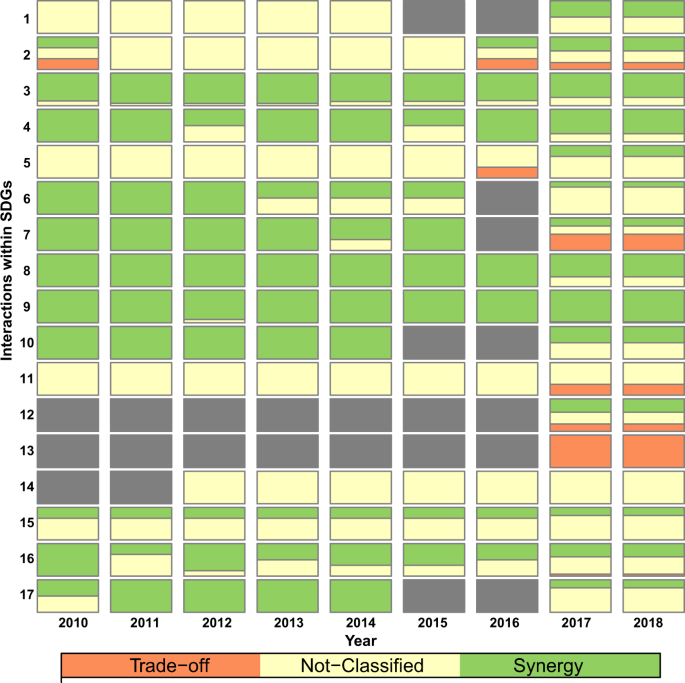
Interactions within SDGs from 2010 to 2018. The color bars represent the shares of trade-offs (orange), synergies (green), and not-classifieds (yellow) observed within a goal. The gray bar depicts insufficient data for the analysis
The majority of goals show synergies between their component sub-indicators that are relatively stable over time. Interestingly, regarding SDG 1 ( No poverty ), SDG 2 ( Zero hunger ), and SDG 5 ( Gender equality ) they have emerged only recently. Before 2016, only weak associations can be observed within these goals. Interactions within SDG 5 have even flipped for a share of trade-offs to synergies between 2016 and 2017. In SDG 2, a mixed share of synergies and trade-offs are observed after 2016, with an increased share of synergies and decreased share of trade-offs. This is a positive sign for a successful implementation of the 2030 Agenda.
Trade-offs are prevalent in particular for SDG 13 ( Climate action ) and SDG 7 ( Affordable and clean energy) , illustrating the difficulty in aligning even the components within a single goal. In the case of SDG 7 these trade-offs have only emerged in 2017 while before the components were in a synergetic relationship with each other. Similarly, for SDG 11 ( Sustainable cities and communities ) mostly weak associations are observed before 2017 that have given way to trade-offs in the recent past. These results illustrate that for certain goals new challenges have arisen regarding successful SDG implementation.
Finally, interactions within many SDGs show that the associations among the indicators have been diluted across time, e.g., within SDG 3 ( Good health and well-being ), SDG 4 ( Quality education ), SDG 6 ( Clean water and sanitation ), SDG 8 ( Decent work and economic growth ), SDG 10 ( Reduced inequalities ), SDG 16 ( Peace, justice and strong institutions ), and SDG 17 ( Partnerships for the goals ). In these cases, shares of synergies have mainly been reduced by increases in shares of not-classified associations in these goals. Such diluting associations show the difficulty of maintaining intra-goal synergies, and might also be due to disproportional progress towards the goals and their targets among the countries.
Interactions between SDGs
Changes in synergies between sdgs.
We turn to interactions between the SDGs and examine 136 SDG pairs over 9 consecutive years, which can be classified into changes in (section “Changes in synergies between SDGs”) synergies, (section “Changes in trade-offs between SDGs”) trade-offs, and (section “Changes in strength of associations between SDGs”) strength of associations. Figure 2 displays the significant increases in the share of synergies (left) and the significant decreases in the share of synergies (right). Between 2010 and 2015, we observe an increase in a share of synergies for nine SDG pairs. This finding is driven by two mechanisms: (i) a decrease of trade-offs and (ii) a strengthening of associations. For example, the indicators for SDG 2 and SDG 6 shows an increase in synergies mainly due to the breaking away of trade-offs. Both SDGs were also part of the MDGs and many countries have made progress on these goals during the MDG period, which might contribute to this increase in synergies. Another such positive example can be seen in the interactions between SDG 13 and SDGs 6, 7, 9, 11, and 16. A large share of trade-offs was converted into synergies in the recent years because of efforts to reduce emissions per capita and reconcile climate action with economic and social outcomes. However, many significant trade-offs remain, as well as in fact a long way to go to meet the well below 2 °C global warming target. Meanwhile, a strengthening of positive associations can be observed, for example, between SDGs 5 and 16.
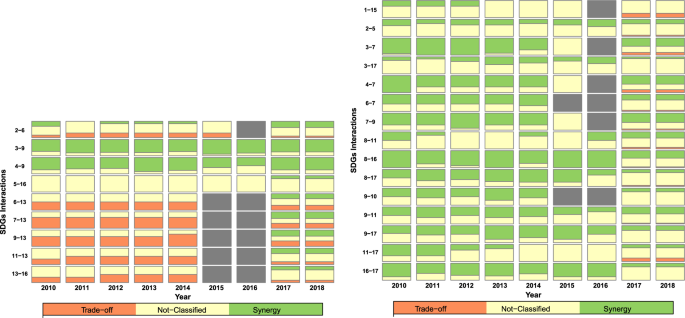
Changes in synergetic association among the SDGs with an increased share of synergies (left) and a decreased share (right). The color bars represent the shares of trade-offs (orange), synergies (green), and not-classifieds (yellow) observed within a goal. The gray bar depicts insufficient data for the analysis
During the same period, we observe a higher number of 15 SDG pairs with a decrease in a share of synergies compared to the nine SDG pairs with an increase in synergies. In most cases, synergies have decreased due to diluting associations between SDG pairs. For example, SDG pair 3–7, 4–7, and 8–16 has shown almost 100% synergies in 2010, which has been reduced to <50% by 2018. This might be alarming in two senses: (i) positive associations might be vanishing and negative ones might be building up and (ii) countries might be having different paces in attaining the SDGs that can increase inequalities between the countries. Increases in trade-offs with a decrease in synergies can already be observed for several SDG pairs, i.e., 1–16, 3–7, 4–7, and 11–17.
Changes in trade-offs between SDGs
Following on a decrease in share of synergies, we observed an increase in the share of trade-offs (Fig. 3 ). In line with the previous sub-section, the number of SDG pairs where trade-offs are increasing (15) is higher than those which are decreasing (9). In most of cases, the mechanism underneath the deterioration is that weak associations among the goals have evolved to trade-offs, e.g. SDG pairs 1–7, 1–15, 8–15, 15–16. These trade-offs are particularly alarming and could hinder the achievement of SDGs. Therefore, a deep investigation for the caused for this is needed in future in-depth research. A good news is reducing trade-offs between some SDGs in this decade, mainly between SDG 13 and SDGs 1, 2, 3, 4, and 5. In this case, trade-offs have been converted to either synergies or weak associations.

Changes in conflicting associations among the SDGs with an increased share of trade-off (left) and a decreased share (right). The color bars represent the shares of trade-offs (orange), synergies (green), and not-classifieds (yellow) observed within a goal. The gray bar depicts insufficient data for the analysis
Changes in strength of associations between SDGs
Between 2010 and 2018, we also observed an increase in weak association among 36 SDG pairs (Fig. 4 ). Most cases are of weakening synergies among the SDG pairs. For example, SDG pairs 1–2, 1–3, 1–4, 1–6, and 1–10 have mostly synergistic relations (a share of more than 66%) in the beginning of the decade, however, the share has decreased up to 40% in these goal pairs, sometimes with an appearance of trade-offs. Nevertheless, weakening of trade-offs has also been observed for some SDG pairs, e.g., 1–14, 2–3, 2–7, 4–5, 2–11, 5–6, and 10–14.
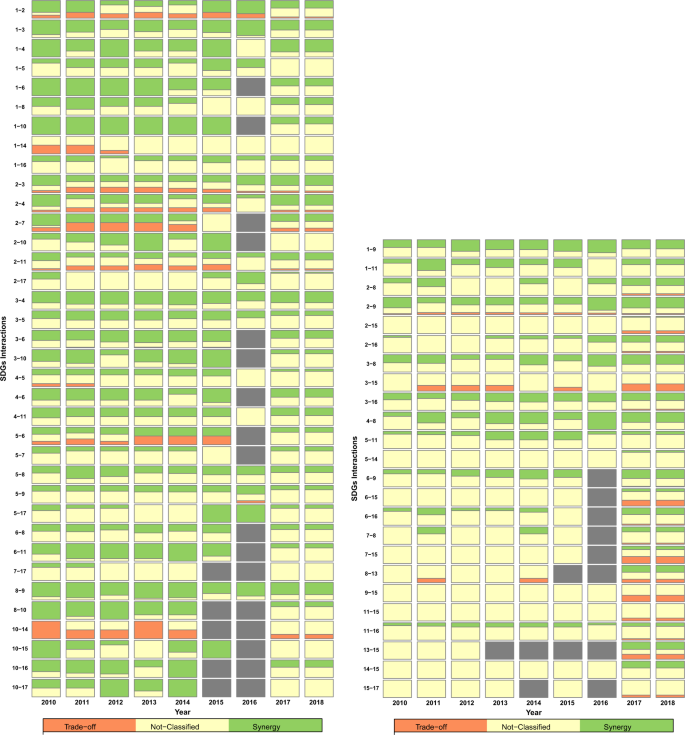
Changes in strength of associations among the SDGs with an diluted association (left) and a strengthened one (right). The color bars represent the shares of trade-offs (orange), synergies (green), and not-classifieds (yellow) observed within a goal. The gray bar depicts insufficient data for the analysis
By contrast, for some SDG interactions the associations, strengthened relations can be observed over time. These are due to an increase in synergies, trade-offs or both. For example, SDG pairs 4–8, 6–9, 6–16, and 7–8 shows strengthening synergistic associations, while associations between SDG 15 and SDGs 2, 3, 9, 11, and 17 evolve toward an increase in trade-offs. For the pairs, SDGs 2–8, 2–16, 6–15, 7–15 and 13–15, both share of synergies and trade-offs increase between 2010 and 2018.
Interactions in the projected SDG trends until 2030
Looking ahead to the year 2030, the question arises how the performance on the SDGs will evolve over time and in particular the interactions between them. Figure 5 displays the results from the first interaction analysis of future SDG trends based on a projected trend variable that extrapolates the development in each country and goal from 2010 to 2015 up until the year 2030 and crucially relates it to the level needed for SDG achievement by then (as opposed to a mere extrapolation).
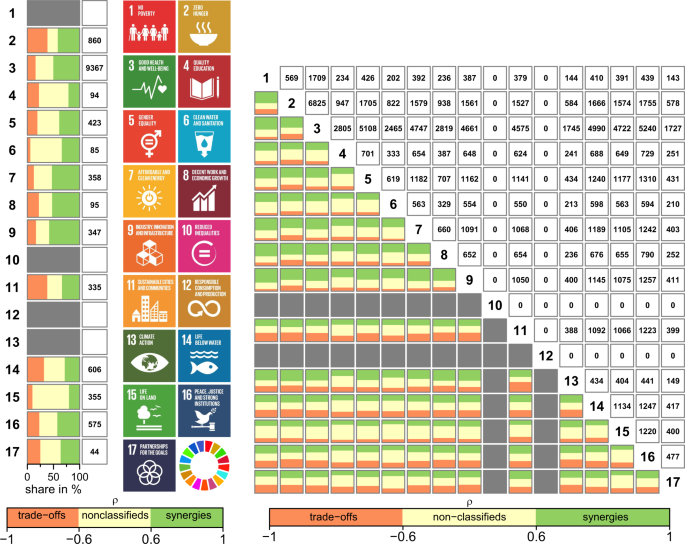
Interactions between sub-indicators within (left) and between (right) projected SDG trends until 2030. The color bars represent the shares of trade-offs (orange), synergies (green), and not-classifieds (yellow) observed within a goal. The gray bar depicts insufficient data for the analysis. The numbers in the boxes represent the number of data pairs used for each analysis. Icon images courtesy of United Nations
In line with our analysis in the section “Interactions within SDGs”, we begin by examining the sub-indicators within each SDG (Fig. 5 , left), since they are often multi-faceted goals in themselves. With regard to the projected developments until 2030, the largest trade-offs that will need to be solved within the SDGs concern SDGs 2 ( Zero hunger ), 11 ( Sustainable cities and communities ), and 14 ( Life below water ). By contrast, the most synergetic elements are to be found within SDGs 3 ( Good health ), 7 ( Affordable and clean energy ), 8 ( Decent work and economic growth ), 9 ( Industry, innovation , and infrastructure ), and 16 ( Peace, justice , and strong institutions ). No results can be obtained here for goals that have insufficient trend data (SDG 10 and 12), or contain only one trend indicator (SDG 1 and 13), respectively.
Figure 5 (right) shows the interactions between projected SDG trends until 2030. It turns out that SDG 1 (No poverty) will have the most synergetic relationships with other SDGs on our way to 2030. We also expect SDGs 3 ( Good health ), 7 ( Affordable and clean energy ), 8 ( Decent work and economic growth ), and 9 ( Industry, innovation and infrastructure ) to have significant synergies with the other goals. The strongest mutually reinforcing relationships in our projections are between the following SDG pairs: 1–3, 1–7, 1–8, 1–9, and 8–9. Poverty alleviation and strengthening the economy, rooted in innovation and modern infrastructure, therefore continue to be the basis upon which many of the other SDGs can be achieved. However, trade-offs are still strongest for SDG 11 ( Sustainable cities and communities ) followed by SDGs 14 ( Life below water ), 16 ( Peace, justice, and strong institutions ) and 17 ( Partnerships for the goals ), and 13 ( Climate action ). In particular, the SDG pairs 9–11 and 11–13 constitute large trade-offs. This finding emphasizes the need to invest in research to foster innovations that can make our cities and communities more sustainable, as well as climate-friendly.
We extend the analysis of interactions between the projected SDG trends by examining high-income countries (HICs) (Fig. 6 ), middle-income countries (MICs) (Fig. 7 ), and low-income countries (LICs) (Fig. 8 ) separately. When examining the sub-indicators within each SDG (left-hand side of Figs 6 – 8 ), it becomes evident that the overall picture is very similar across all income groups: Countries will face similar challenges with regard to intra-goal consistency regardless of their current stage of development. The only notable differences concern SDGs 6 ( Clean water and sanitation ) and 15 ( Life on land ). For SDG 6, no synergies can be observed for HICs but their share rises for MICs and especially LICs. This finding lends support to the notion that as countries develop, the pressure to provide accessible and yet sustainable water systems will intensify in the future. By contrast, HICs show synergies regarding SDG 15 that are weaker for MICs and almost non-existent for LICs. Biodiversity protection is therefore beginning to pay off in developed regions, while the conditions for Life on land are projected to become more difficult especially in MICs and LICs. This finding sheds a light of urgency onto current public discussions around protecting green spaces, such as the Amazon forest versus economic interests.
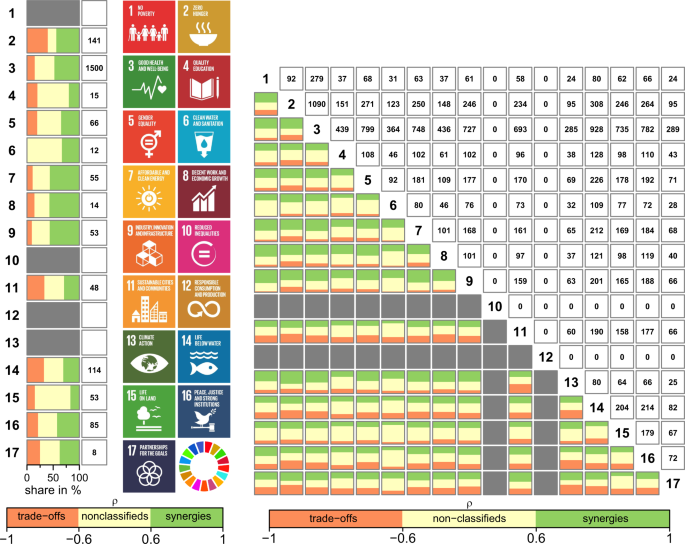
Interactions between sub-indicators within (left) and between (right) projected SDG trends until 2030 for high-income countries. The color bars represent the shares of trade-offs (orange), synergies (green), and not-classifieds (yellow) observed within a goal. The gray bar depicts insufficient data for the analysis. The numbers in the boxes represent the number of data pairs used for each analysis. Icon images courtesy of United Nations
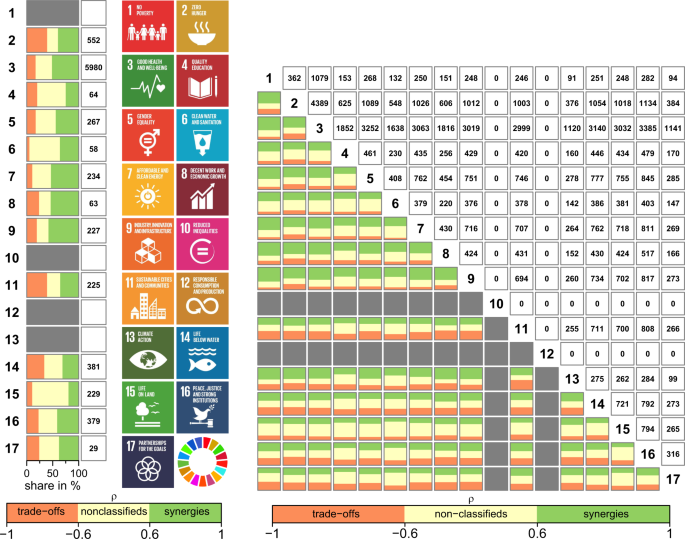
Interactions between sub-indicators within (left) and between (right) projected SDG trends until 2030 for middle-income countries. The color bars represent the shares of trade-offs (orange), synergies (green), and not-classifieds (yellow) observed within a goal. The gray bar depicts insufficient data for the analysis. The numbers in the boxes represent the number of data pairs used for each analysis. Icon images courtesy of United Nations
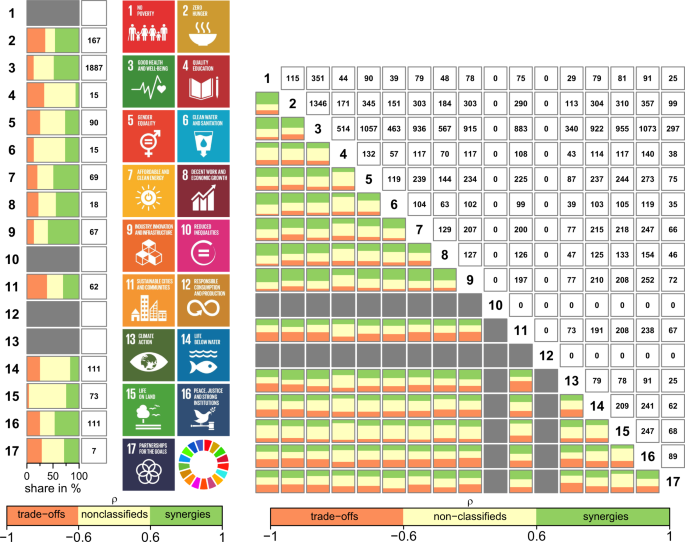
Turning to interactions between projected SDG trends until 2030 by income group (right-hand side of Figs 6 – 8 ), we see again a similar picture overall for all stages of development. It becomes evident, however, that for certain goals the share of projected trade-offs is lower compared to MICs and especially LICs. This is especially true for SDG 6 ( Clean water and sanitation ) and SDG 13 ( Climate action ). In other words: The pressure on pursuing climate action as well as clean water and sanitation that is not detrimental for achieving the other goals is likely to rise especially for LICs in the coming years. Unless HICs provide the technical and financial assistance necessary to let LICs benefit from state-of-the-art solutions in this regard, the development gap will rise even more at the expense of the planet and all its inhabitants—rich and poor.
Discussion: Towards a virtuous cycle of SDG progress
This study asked the timely questions: How have interactions within and between the 17 SDGs across countries evolved over time? Are we successful in moving from trade-offs to synergies? Most importantly, we provided the first analysis of interlinkages for projected SDG achievement trends until 2030.
For some goals we found positive developments with diminishing trade-offs and increasing synergies with other SDGs. This was particularly strong, for example, for SDG interactions between SDG 13 ( Climate action ) and SDG 9 ( Industry, innovation and infrastructure ), as well as SDG 13 and SDG 11 ( Sustainable cities and communities ). Such findings provide some support to the notion that climate-friendly infrastructure is beginning to spread, which not only improves the quality of life in cities and communities but mitigates the dangers of global warming, although our data do not provide evidence of a causal link. Likewise, synergies have begun to emerge in the recent past between SDG 5 ( Gender equality ) and SDG 16 ( Peace and justice, strong institutions ) indicating to some extent that as countries are getting better at providing strong institutions, this development may be beneficial to equality between men and women, or vice versa. In any event, such efforts will have to be significantly intensified over the next decade in order to reach the SDGs, and in these particular examples also the Paris Climate Accord and long overdue gender equality, respectively. Nonetheless, these best practices of turning trade-offs into synergies (see Fig. 2 left, Fig. 3 right, Fig. 4 right) may inform a learning process rooted in more in-depth research to expand the lessons onto other goals with more persistent trade-offs.
For numerous SDG interactions, though, the synergies are diminishing and trade-offs as well as non-associations are increasing. This worrying finding was particularly strong for the interactions, for instance, between SDG 7 ( Affordable and clean energy ) and SDG 1 ( No poverty ), as well as SDG 7 and SDG 3 ( Good health and well-being ). This means that as countries manage to lift millions out of poverty and provide much-needed health care, the demands on affordable and clean energy currently rises at a rate that jeopardizes progress regarding the Agenda 2030. Further investments in smart solutions and research on energy supply that can meet these new demands without putting too much pressure on planetary boundaries will be needed in the future.
Comparing our cross-sectional analysis with longitudinal analysis performed by Pradhan et al. ( 2017 ), we obtained similarities and differences. Our findings are similar in the sense that we also found, overall, a larger share of synergies than trade-offs within and across the goals. Both studies also highlight that eliminating poverty (SDG1) and improving health and well-being (SDG3) will have large synergies with other goals. However, one of the key differences is that we observed a larger share of not-classified associations in our cross-sectional analysis in comparison to the results of the longitudinal analysis by Pradhan et al. A reason for this is that our cross-sectional analysis covers a large spectrum of data from the whole range between developed and developing countries. By contrast, the aforementioned longitudinal analysis only has a comparatively narrow range of countries for the investigated period.
We provided the first analysis of future interactions between projected SDG trends until 2030, and found that SDG 1 ( No poverty ) will have the most synergetic relationships with other SDGs. In clear terms, this means that eliminating extreme poverty in developing countries and reducing relative poverty in more advanced nations will be a policy strategy that, given limited resources and the need for prioritization, will yield the most significant benefits beyond just this one policy goal of No poverty . Focusing on SDG 1 would therefore be the most promising strategy to ultimately start-off a virtuous cycle of SDG progress. For example, a family that no longer suffers from extreme poverty (SDG1) will be able to lead healthier lives for themselves and others, halting the spread of infectious diseases (SDG 3), contributing to a stronger economy (SDG 8), raising the means of implementation through tax payments (SDG 17) which will in turn enable public investments in infrastructure (SDG 9), which will provide education and other important services (SDG 4). The key challenge for policymakers here will then be to emulate such synergetic relationships with respect to other goals.
Despite those strong synergies, however, we were able to show that all SDG interactions between projected SDG trends until 2030 still contain a significant portion of trade-offs. This outlook into the future gives further reason for concern, and indeed casts a shadow on even most of the positive findings from our analysis of the past and present, for example regarding SDG 13 ( Climate action ). While we had hypothesized that synergies will occupy a larger portion in our projections of the interlinkages than trade-offs, the results indicated a nuanced picture with notable synergies for SDGs 1, 3, 7, 8 and 9, while especially SDGs 11, 13, 14, 16, and 17 are likely to have notable trade-offs with the other goals going forward.
Further distinguishing by income group has shown that, overall, countries will face similar challenges in terms of projected trade-offs and synergies across all stages of development. There were notable differences, however, especially to the detriment of LICs in the projected trade-offs for SDGs 6 ( Clean water and sanitation ) and 13 ( Climate action ) being larger than in HICs. This finding provides both an imperative and incentive for the latter to step up their technical and financial efforts to let LICs benefit from the latest advances which are already being implemented in HICs, e.g. in terms of the growing accessibility and affordability of solar panels in order to reduce emissions. It is very much in the interest of the rich countries themselves given the potentially harmful effects of a lack of climate protection by the growing populations in MICs and LICs on the HICs.
Our analysis is limited by the availability of data, which remains a challenge in SDG monitoring. A number of data gaps persist that prevent us from analyzing several SDG interactions, and the number of available SDG indicators fluctuates. Further efforts must be made by data providers to close these gaps in the future. This is especially important given the fact that 2015 is the baseline year in which the SDGs were signed into action, and most synergies/trade-offs will materialize with a time lag. We also emphasize that the method used in our paper, Spearman’s correlation, is useful to establish empirically whether improvements in one SDG go together with improvements (synergy) or deteriorations (trade-off) in another SDG. The method does not, however, allow us to determine causation. Where the terms of synergy and trade-off are used in our study, it happens in an understanding that causation is potentially from a to b, b to a, or both ways. This approach is in line with other studies on SDG interactions as quoted in our paper. In order to establish causation in the large number of interactions examined here, comprehensive additional analyses over time are required. They go beyond the scope of this paper but should be performed in future research (in a series of papers given the complexity of the task), and we hope to have sparked research along those lines with our initial inquiry.
In future research, we additionally recommend that the complexity of the SDG system be represented not only by a series of pairwise interactions but as a network, where both direct and indirect interactions produce synergies and trade-offs. The analysis according to income groups provides promising avenues for future research, and should in fact be complemented in the future by analyses that distinguish not just by income group but also by region or political system, for instance. Nonetheless, we hope that our initial findings present a useful inspiration for examining in more detail the promising patterns we have identified.
Our results may have important implications for global institutions, first and foremost the UN High-level Political Forum on Sustainable Development (HLPF), where countries meet annually to review progress on the SDGs. While the country-led Voluntary National Reviews (VNRs) are now an established tool to showcase what each country is doing in terms of progressing towards Agenda 2030 using a basket of indicators, a perspective on the interlinkages between the goals is still missing despite being crucial to the fulfillment of the goals as our study indicates. The review process of the HLPF should therefore require countries to report on what is the status of SDG interlinkages in their country (in terms of existing and projected synergies and trade-offs), as well as to outline a policy strategy to deal with these interlinkages. Country processes of SDG implementation, as well as coordination mechanisms by international organizations on Agenda 2030 should make more use of the findings on SDG interlinkages. For example, by using the evidence as a tool to inform budget allocation with a view to maximizing effect of the money spent. Likewise, research on the SDGs should by default take into account the fact that there are important interlinkages between the goals, and incorporate such effects into analytical design as well as the formulation of implications.
All in all, our findings offer a starting point for how researchers and policymakers can resolve the challenge of interactions between the SDGs, in particular regarding the persistent issue of trade-offs. We have identified best practices where it has been possible over the last 9 years to turn trade-offs into synergies. Further research should build on these successful examples and explore in depth the drivers and mechanism that enabled them. At the same time, we have found evidence of a widespread and alarming inability to overcome trade-offs and indeed a deterioration in this regard for certain SDGs. Further research into how these trends can be reversed is urgently needed as otherwise they will seriously threaten the achievement of the UN Agenda 2030.
Data availability
The datasets analyzed during the current study are available from www.sdgindex.org .
Akuraju V, Pradhan P, Haase D, Kropp J. P, Rybski D (2020) Relating SDG11 indicators and urban scaling—An exploratory study. Sustain Cities and Soc 52:101853
Article Google Scholar
Allen C, Metternicht G, Wiedmann T (2019) Prioritising SDG targets: assessing baselines, gaps and interlinkages Sustain Sci 14:421. https://doi.org/10.1007/s11625-018-0596-8
Bue MCL, Klasen S (2013) Identifying synergies and complementarities between MDGs: results from cluster analysis Soc Indic Res 113(2):647–670. https://doi.org/10.1007/s11205-013-0294-y
Breuer A, Janetschek H, Malerba D (2019) Translating sustainable development goal (SDG) interdependencies into policy advice Sustainability 11(7):2092. https://doi.org/10.3390/su11072092
Costanza R, Fioramonti L, Kubiszewski I (2016) The UN sustainable development goals and the dynamics of well-being Front Ecol Environ 14(2):59–59. https://doi.org/10.1002/fee.1231
Diaz-Sarachaga JM, Jato-Espino D, Castro-Fresno D (2018) Is the Sustainable Development Goals (SDG) index an adequate framework to measure the progress of the 2030 Agenda? Sustain Dev 26:663–671
Engström et al. (2019) Cross-scale water and land impacts of local climate and energy policy—a local Swedish analysis of selected SDG interactions. Sustainability 11:1847
Ibisch PL, Hoffmann MT, Kreft S, Pe’er G, Kati V, Biber-Freudenberger L, DellaSala DA, Vale MM, Hobson PR, Selva N (2016) A global map of roadless areas and their conservation status. Science 354(6318):1423–1427. https://doi.org/10.1126/science.aaf7166
Article ADS CAS PubMed Google Scholar
Lu Y, Nakicenovic N, Visbeck M, Stevance A-S (2015) Policy: five priorities for the UN sustainable development goals—comment. Nature 520(7548):432–433. https://doi.org/10.1038/520432a
Article ADS PubMed Google Scholar
Lusseau D, Mancini F (2019) Income-based variation in Sustainable Development Goals interaction networks. Nat Sustain 2:242–247
Mathy S, Blanchard O (2016) Proposal for a poverty-adaptation-mitigation window within the green climate fund. Clim Policy 16(6):752–767. https://doi.org/10.1080/14693062.2015.1050348
Moyer JD, Bohl DK (2019) Alternative pathways to human development: assessing trade-offs and synergies in achieving the Sustainable Development Goals. Futures 105:199–210
Nature Sustainability Editorial (2018). https://www.nature.com/articles/s41893-018-0131-z
Nerini F et al. (2018) Mapping synergies and trade-offs between energy and the sustainable development goals. Nat Energy 3:10–15
Article ADS Google Scholar
Nilsson M, Griggs D, Visbeck M (2016) Policy: map the interactions between sustainable development goals. Nature 534:320–322. https://doi.org/10.1038/534320a
Pradhan P (2019) Antagonists to meeting the 2030 Agenda. Nat Sustain 2:171–172
Pradhan P, Costa L, Rybski D, Lucht W, Kropp JP (2017) A systematic study of sustainable development goal (SDG) interactions. Earth’s Future 5:1169–1179. https://doi.org/10.1002/2017EF000632
Rickels W, Dovern J, Hoffmann J, Quaas MF, Schmidt JO, Visbeck M (2016) Indicators for monitoring sustainable development goals: an application to oceanic development in the European union. Earth’s Future 4(5):252–267. https://doi.org/10.1002/2016EF000353
Sachs JD (2012) From millennium development goals to sustainable development goals. Lancet 379(9832):2206–2211. https://doi.org/10.1016/S0140-6736(12)60685-0
Article PubMed Google Scholar
Sachs J, Schmidt-Traub G, Kroll C, Lafortune G, Fuller G (2018) Implementing the goals. SDG index report 2018. Bertelsmann Stiftung and Sustainable Development Solutions Network, New York
Google Scholar
Scherer et al. (2018) Trade-offs between social and environmental Sustainable Development Goals. Environ Sci Policy 90:65–72. https://doi.org/10.1016/j.envsci.2018.10.002
Schmidt H, Gostin L, Emanuel E (2015) Public health, universal health coverage, and sustainable development goals: can they coexist? Lancet 386(9996):928–930. https://doi.org/10.1016/S0140-6736(15)60244-6
Schmidt-Traub G, Kroll C, Teksoz K, Durand-Delacre D, Sachs J (2017) National baselines for the Sustainable Development Goals assessed in the SDG index and dashboards. Nat Geosci 10(8):547–555
Article ADS CAS Google Scholar
Smarandache F (2009) Alternatives To Pearson’s and Spearman’s correlation coefficients florentin. Bull Stat Econ 3(S09):47–53
MathSciNet Google Scholar
Smith P, Olesen JE (2010) Synergies between the mitigation of, and adaptation to, climate change in agriculture. J Agric Sci 148(05):543–552. https://doi.org/10.1017/S0021859610000341
Article CAS Google Scholar
Stiglitz J, Sen Amartya K & Fitoussi Jean-Paul (2009) The measurement of economic performance and social progress revisited: reflections and overview. Sciences Po publications, Paris, pp 2009–2033
Stiglitz J, Fitoussi J-P, Durand M (2018) For good measure. Advancing research on well-being metrics beyond GDP. OECD Publishing, Paris
United Nations (2015) Transforming our world: the 2030 agenda for sustainable development. http://www.un.org/ga/search/view_doc.asp?symbol=A/RES/70/1&Lang=E
Download references
Acknowledgements
CK and PP designed study; CK, AW, and PP collected and analyzed data; CK and PP wrote manuscript. The authors gratefully acknowledge financial support from the Potsdam Institute for Climate Impact Research and Bertelsmann Stiftung. AW acknowledges funding from the German Federal Ministry of Education and Research (BMBF) for the SUSFOOD project (grant agreement No. 01DP17035). PP acknowledges funding from the German Federal Ministry for the Environment, Nature Conservation, Building, and Nuclear Safety for the I-CCC project (Contract No. 81227263) and the European Union’s Horizon 2020 research and innovation program under for the European calculator project (grant agreement No. 730459).
Author information
Authors and affiliations.
SDG Index & Dashboards, Berlin, Germany
Christian Kroll
Potsdam Institute for Climate Impact Research (PIK), Member of Leibniz Association, P.O. Box 601203, 14412, Potsdam, Germany
Anne Warchold & Prajal Pradhan
You can also search for this author in PubMed Google Scholar
Corresponding author
Correspondence to Christian Kroll .
Ethics declarations
Competing interests.
The authors declare no competing interests.
Additional information
Publisher’s note Springer Nature remains neutral with regard to jurisdictional claims in published maps and institutional affiliations.
Rights and permissions
Open Access This article is licensed under a Creative Commons Attribution 4.0 International License, which permits use, sharing, adaptation, distribution and reproduction in any medium or format, as long as you give appropriate credit to the original author(s) and the source, provide a link to the Creative Commons license, and indicate if changes were made. The images or other third party material in this article are included in the article’s Creative Commons license, unless indicated otherwise in a credit line to the material. If material is not included in the article’s Creative Commons license and your intended use is not permitted by statutory regulation or exceeds the permitted use, you will need to obtain permission directly from the copyright holder. To view a copy of this license, visit http://creativecommons.org/licenses/by/4.0/ .
Reprints and permissions
About this article
Cite this article.
Kroll, C., Warchold, A. & Pradhan, P. Sustainable Development Goals (SDGs): Are we successful in turning trade-offs into synergies?. Palgrave Commun 5 , 140 (2019). https://doi.org/10.1057/s41599-019-0335-5
Download citation
Received : 08 July 2019
Accepted : 24 September 2019
Published : 12 November 2019
DOI : https://doi.org/10.1057/s41599-019-0335-5
Share this article
Anyone you share the following link with will be able to read this content:
Sorry, a shareable link is not currently available for this article.
Provided by the Springer Nature SharedIt content-sharing initiative
This article is cited by
Synthesis and application of an eco-friendly cellulose diacrylate-carbon nanocomposite: a highly effective inhibitor for clay swelling in water-based drilling fluids.
- Sohail Nadeem
- Mobeen Murtaza
- Ayesha Mohyuddin
Arabian Journal for Science and Engineering (2024)
China’s safe and just space during 40 years of rapid urbanization and changing policies
- Hongyan Bian
Landscape Ecology (2024)
An empirical model for branding oriented by the environmental sustainability of the Amazon Rainforest: a hybrid structural equation modeling with fsQCA approach
- Luiz Diego Vidal Santos
- Francisco Sandro Rodrigues Holanda
- Ana Paula Schervinski Villwock
Discover Analytics (2024)
Fostering plant growth performance under drought stress using rhizospheric microbes, their gene editing, and biochar
- Prabhat K. Chauhan
- Sudhir K. Upadhyay
- Ming Hung Wong
Environmental Geochemistry and Health (2024)
The impacts of decarbonization pathways on Sustainable Development Goals in the European Union
- Jorge Moreno
- Lorenza Campagnolo
- Marc Vielle
Communications Earth & Environment (2024)
Quick links
- Explore articles by subject
- Guide to authors
- Editorial policies

Take Action for the Sustainable Development Goals
The Sustainable Development Goals are the blueprint to achieve a better and more sustainable future for all. They address the global challenges we face, including those related to poverty, inequality, climate change , environmental degradation, peace and justice. The 17 Goals are all interconnect ed, and in order to leave no one behind, it is important that we achieve them all by 2030. Click on any specific Goal below to learn more about each issue and take action.
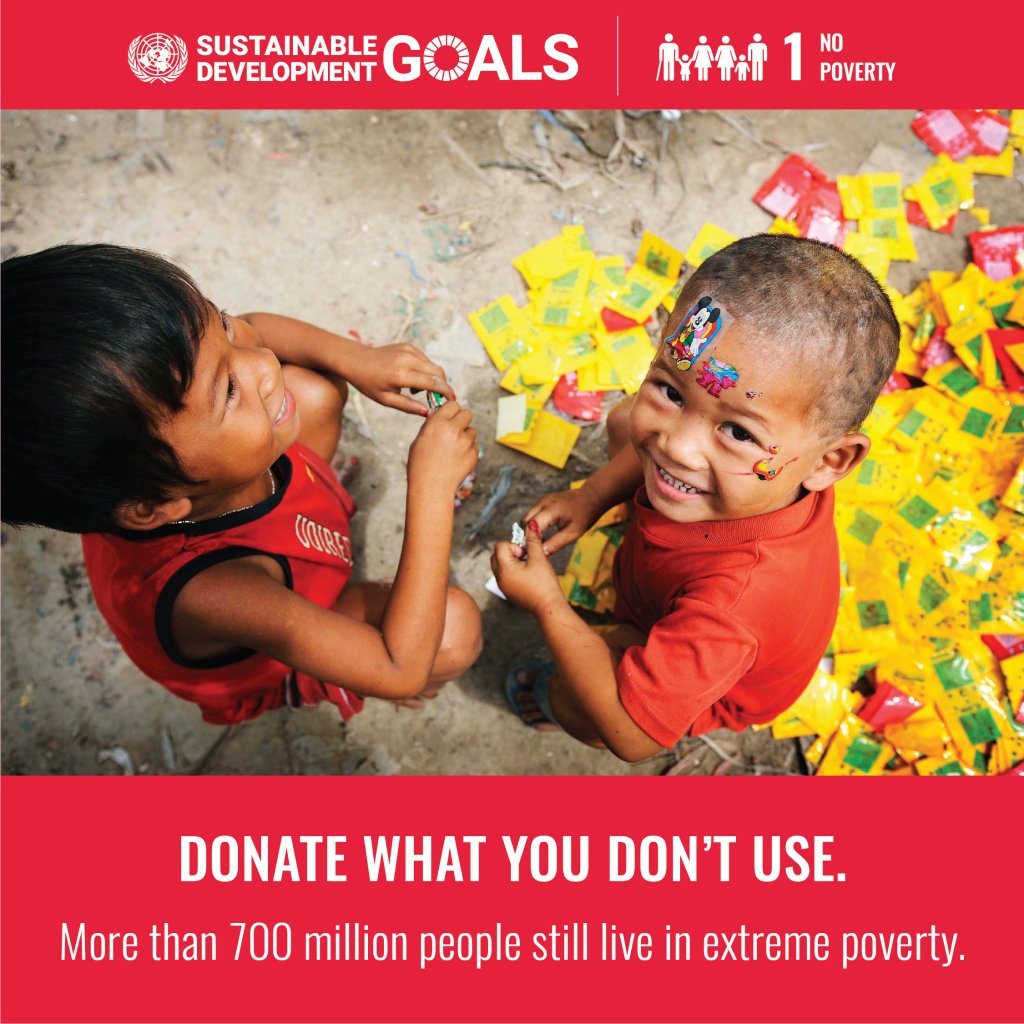
Goal 1: No Poverty
Economic growth must be inclusive to provide sustainable jobs and promote equality.
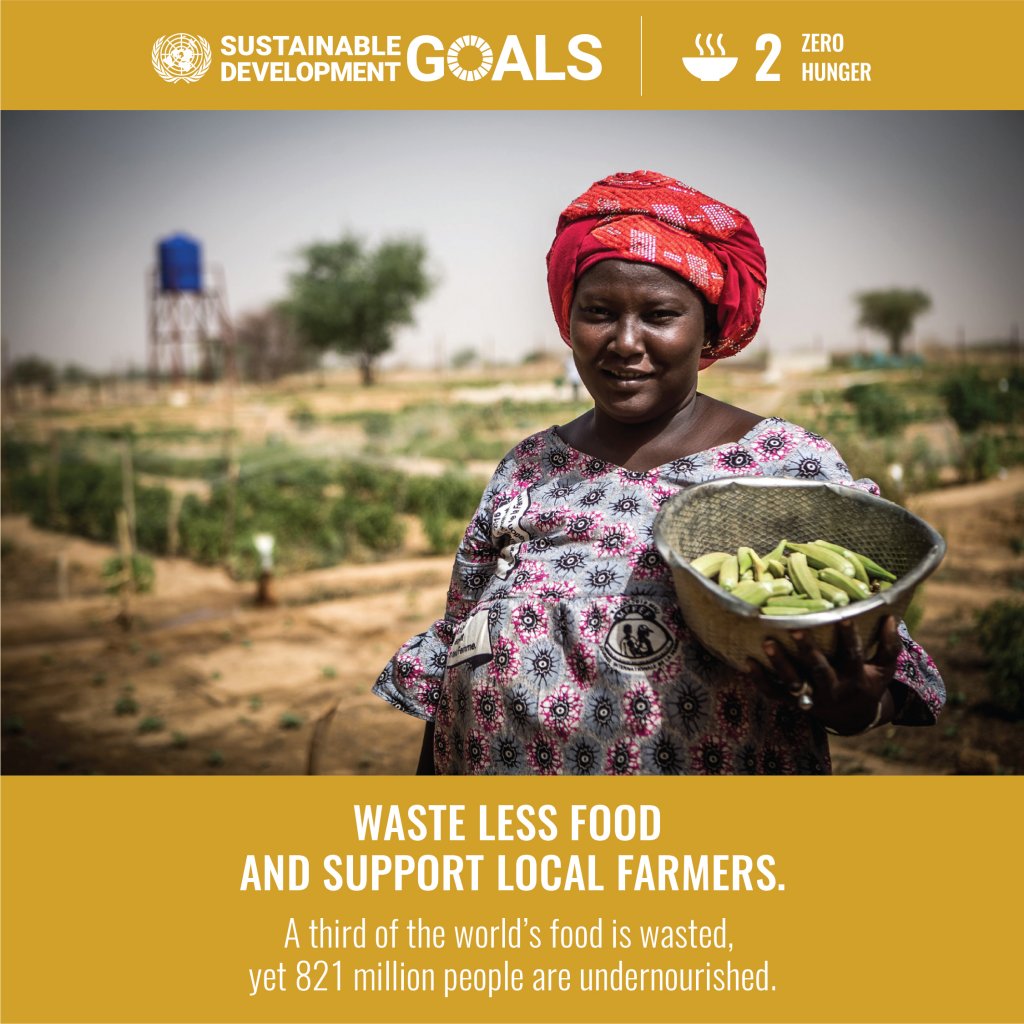
Goal 2: Zero Hunger
The food and agriculture sector offers key solutions for development, and is central for hunger and poverty eradication.
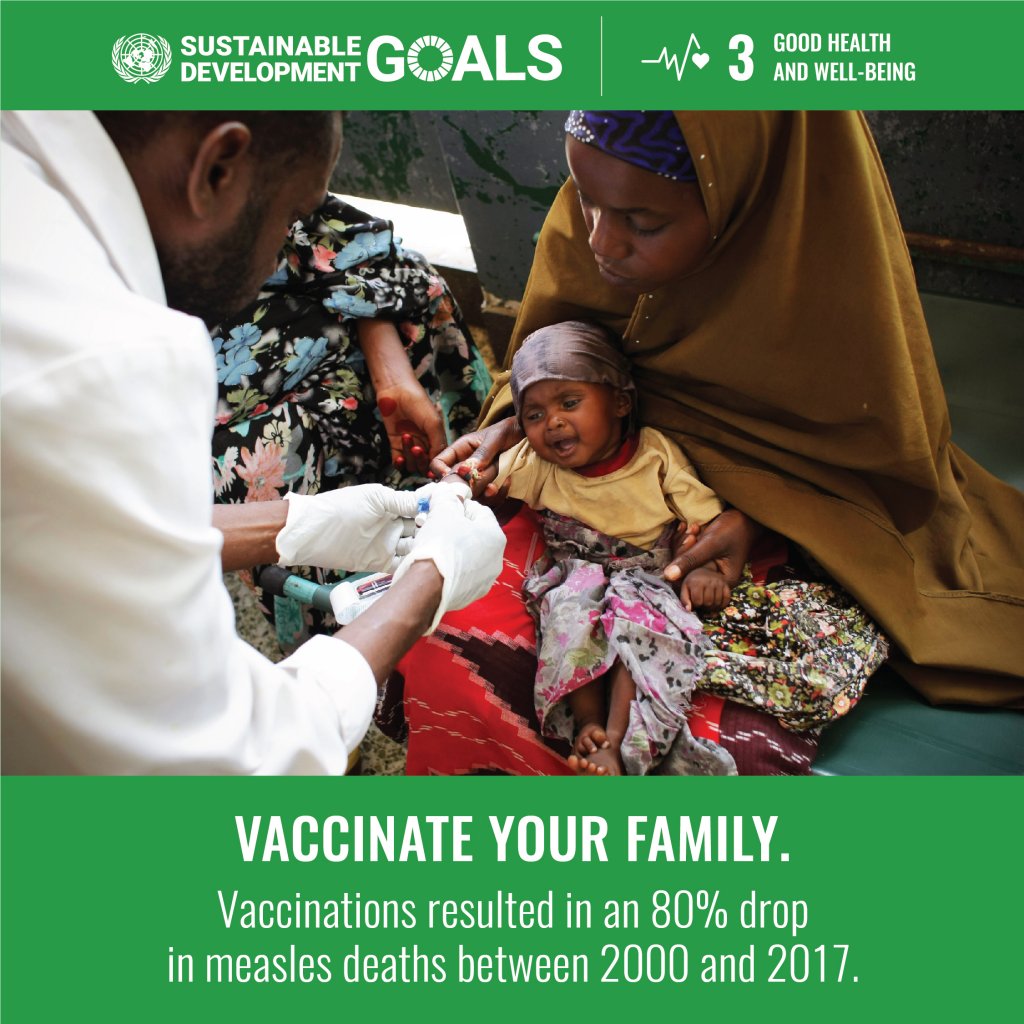
Goal 3: Good Health and Well-Being
Ensuring healthy lives and promoting the well-being for all at all ages is essential to sustainable development.
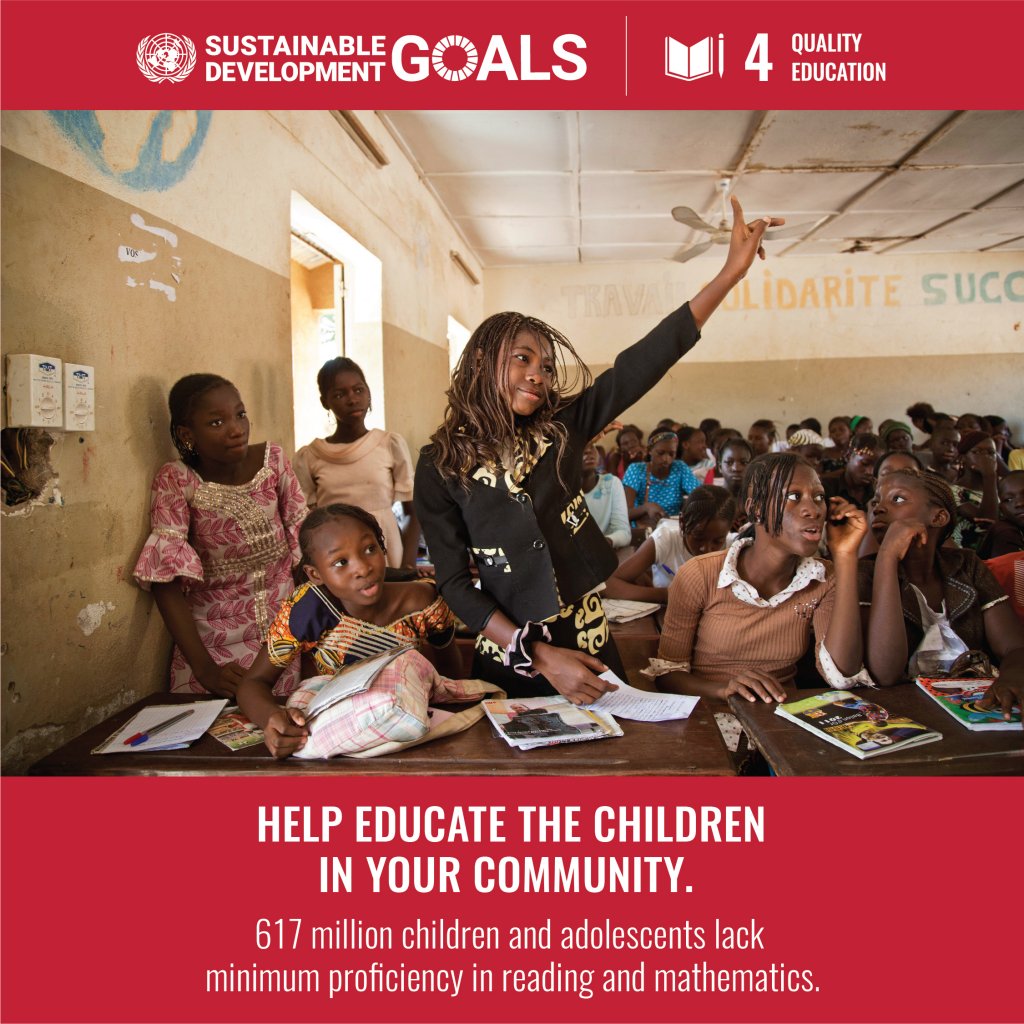
Goal 4: Quality Education
Obtaining a quality education is the foundation to improving people’s lives and sustainable development.
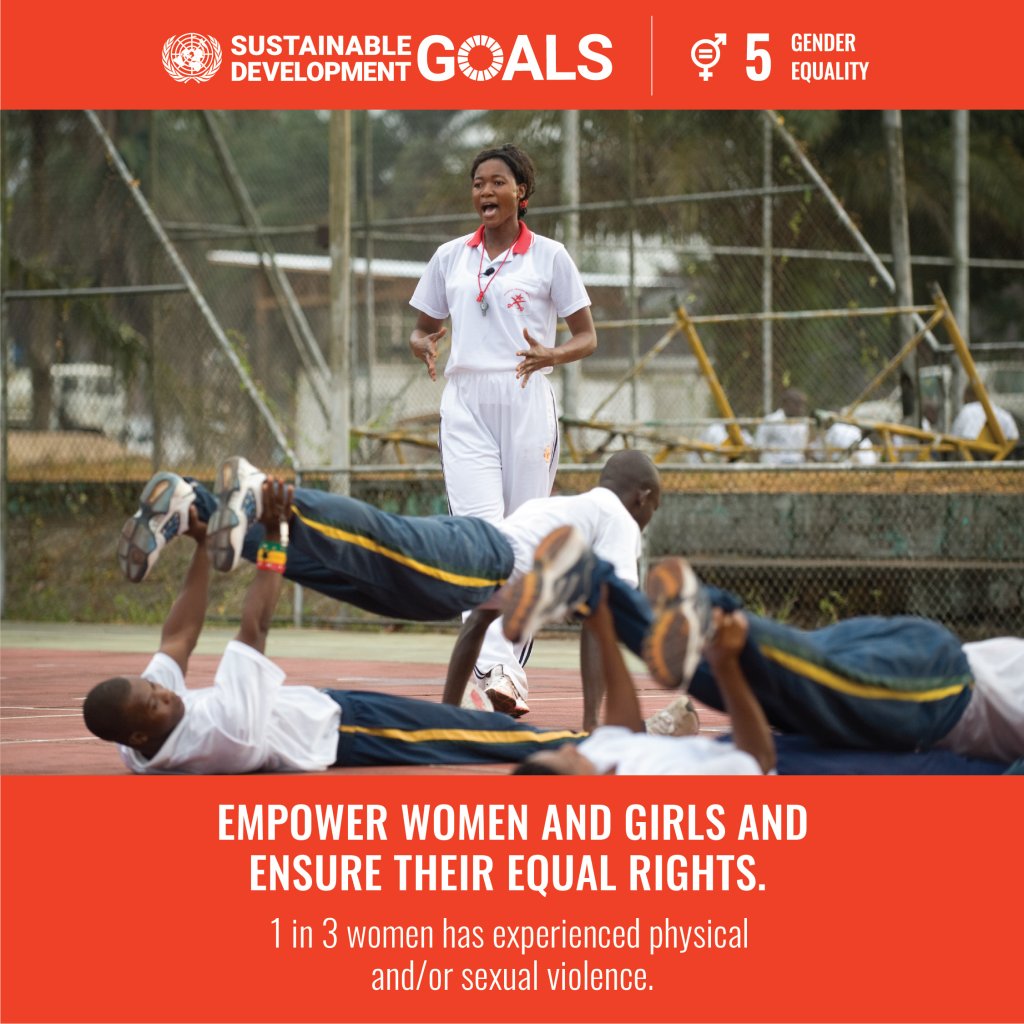
Goal 5: Gender Equality
Gender equality is not only a fundamental human right, but a necessary foundation for a peaceful, prosperous and sustainable world.
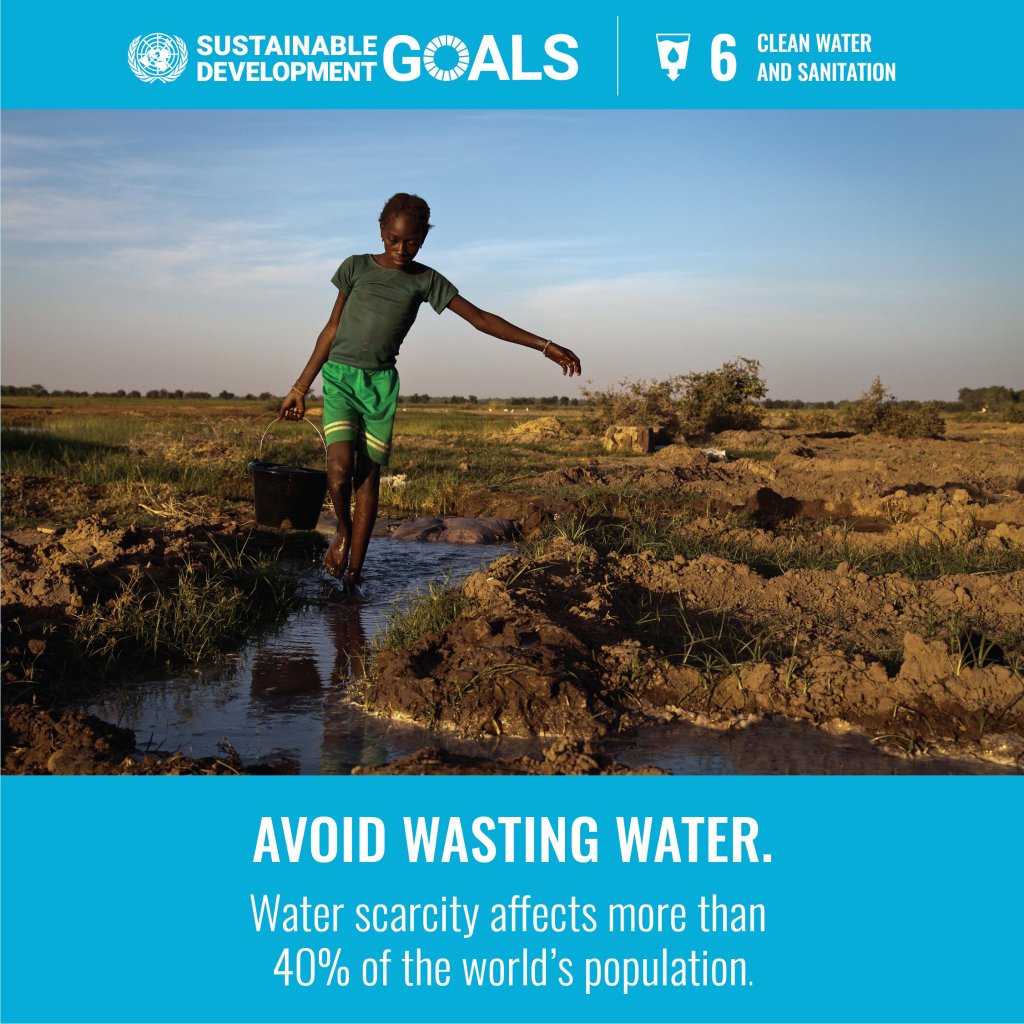
Goal 6: Clean Water and Sanitation
Clean, accessible water for all is an essential part of the world we want to live in.
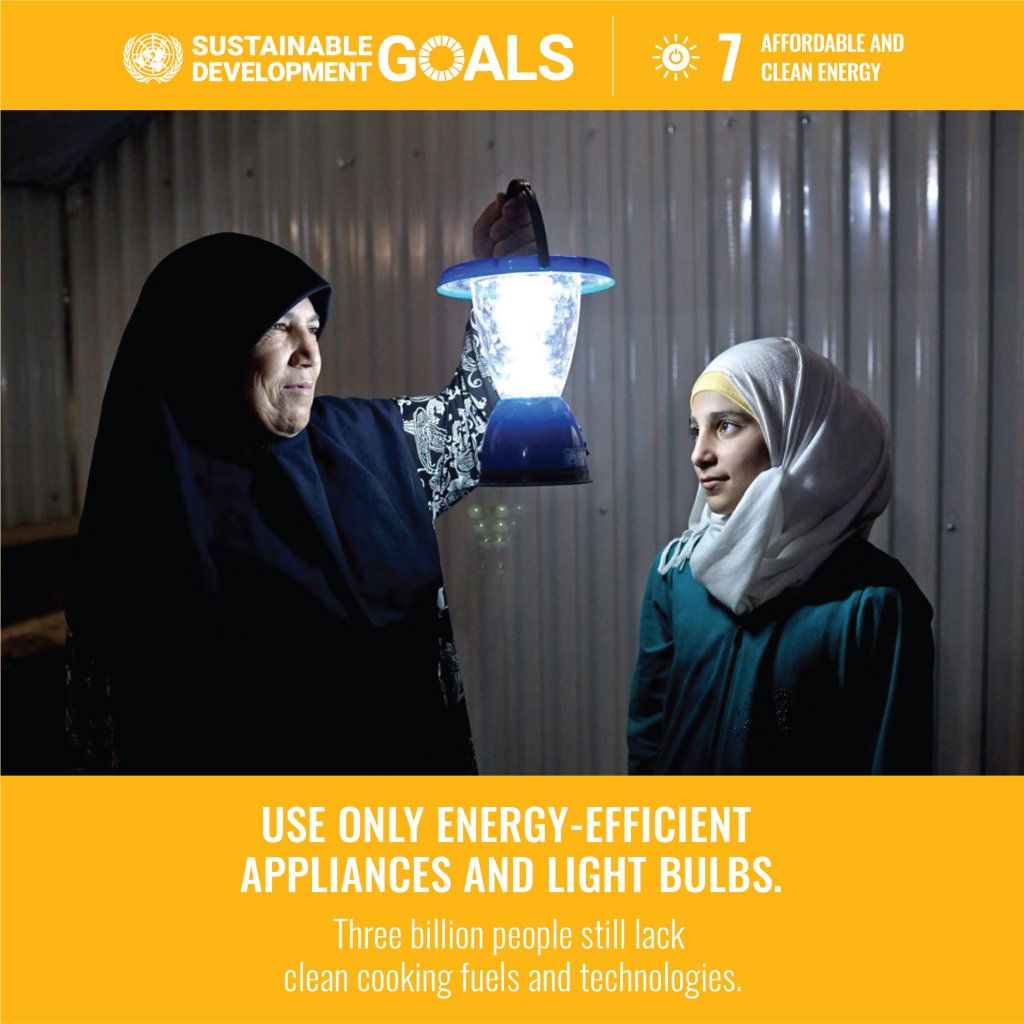
Goal 7: Affordable and Clean Energy
Energy is central to nearly every major challenge and opportunity.
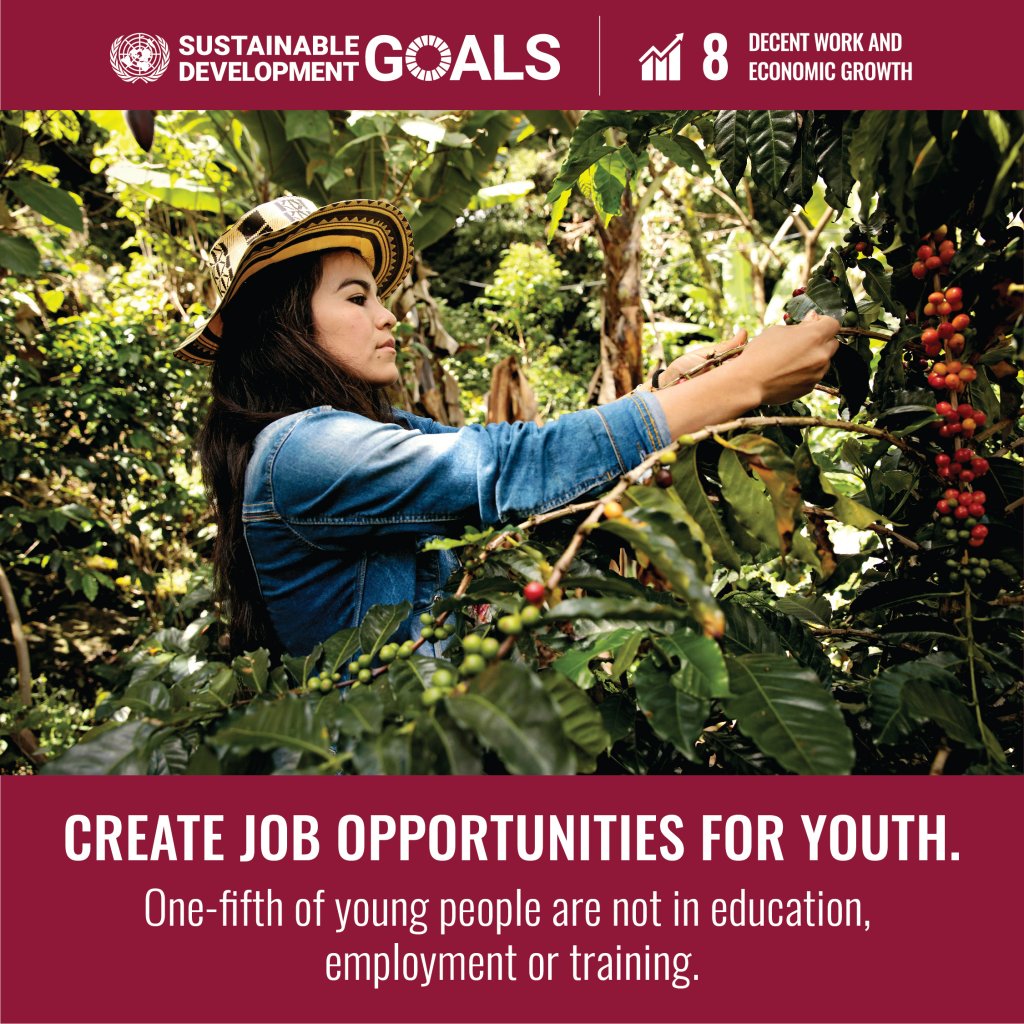
Goal 8: Decent Work and Economic Growth
Sustainable economic growth will require societies to create the conditions that allow people to have quality jobs.
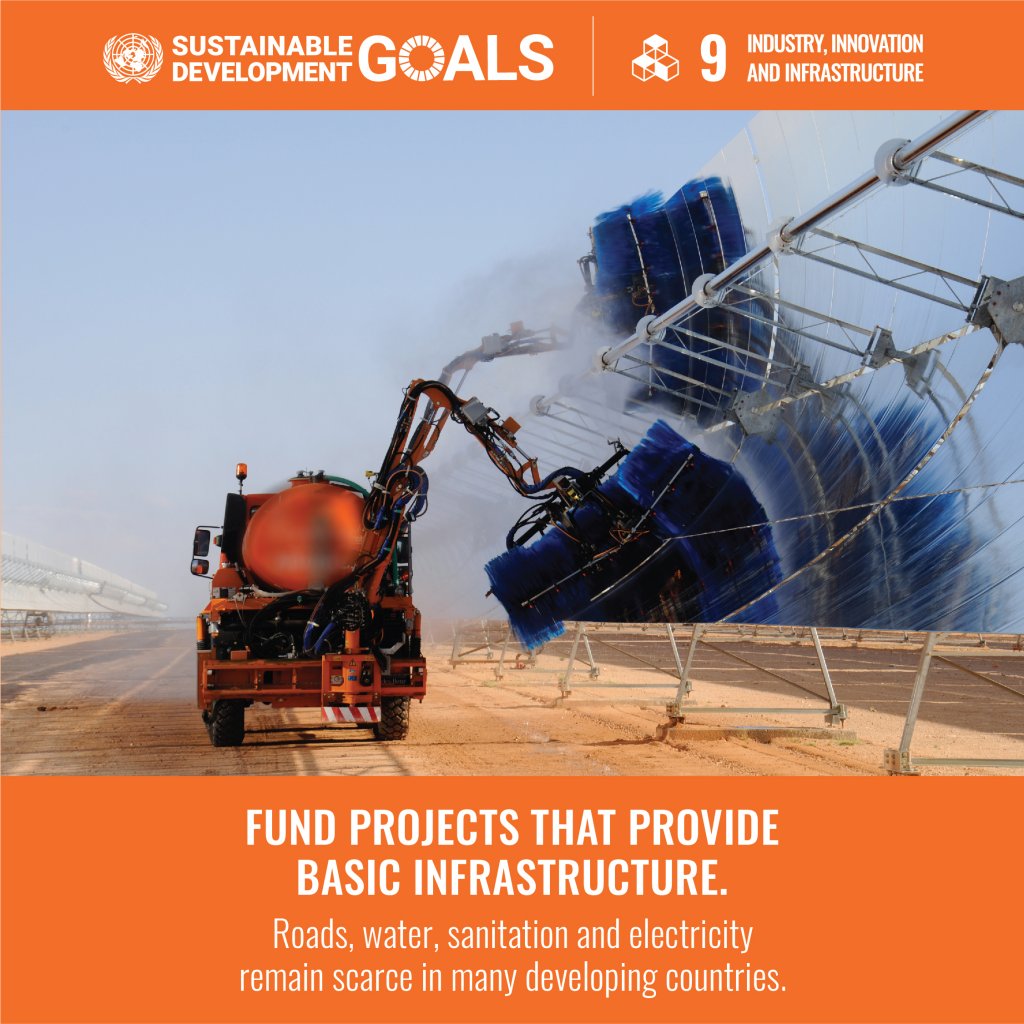
Goal 9: Industry, Innovation, and Infrastructure
Investments in infrastructure are crucial to achieving sustainable development.
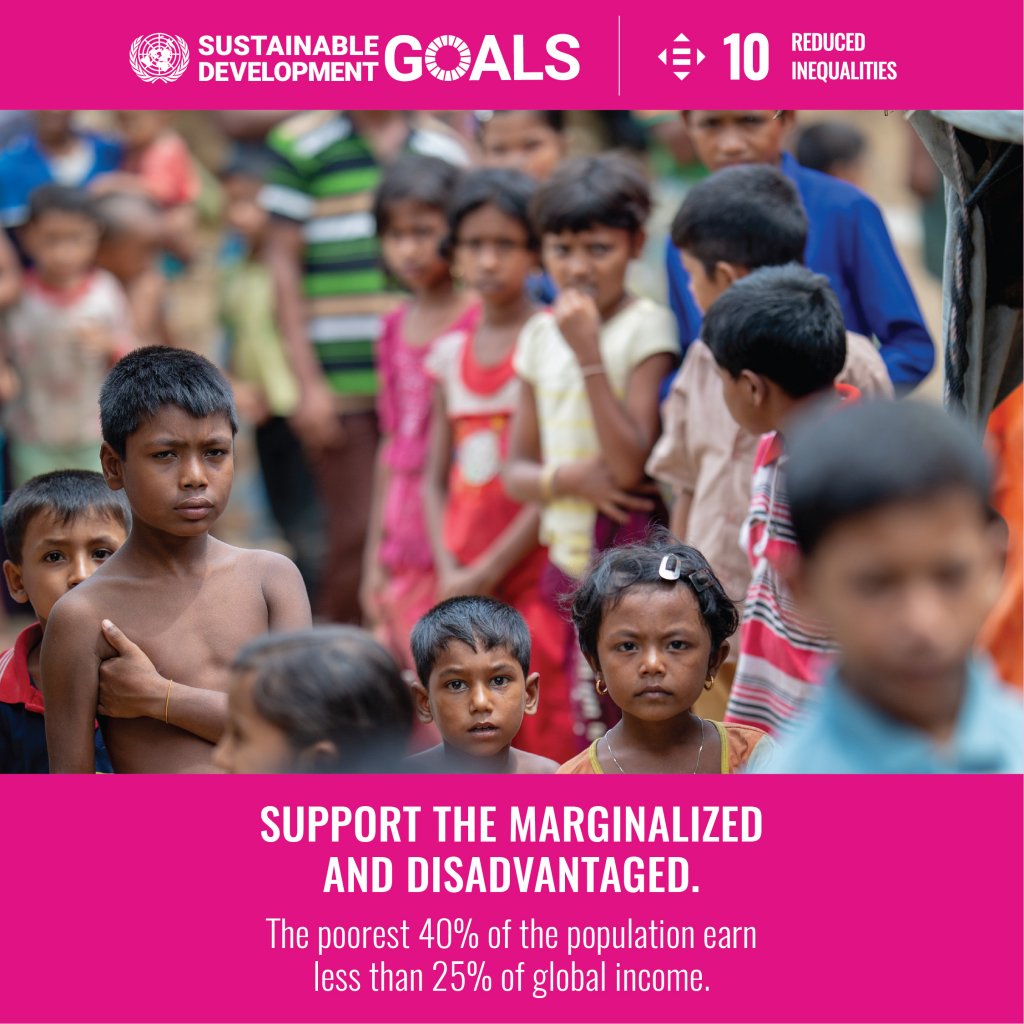
Goal 10: Reduced Inequalities
To reduce inequalities, policies should be universal in principle, paying attention to the needs of disadvantaged and marginalized populations.
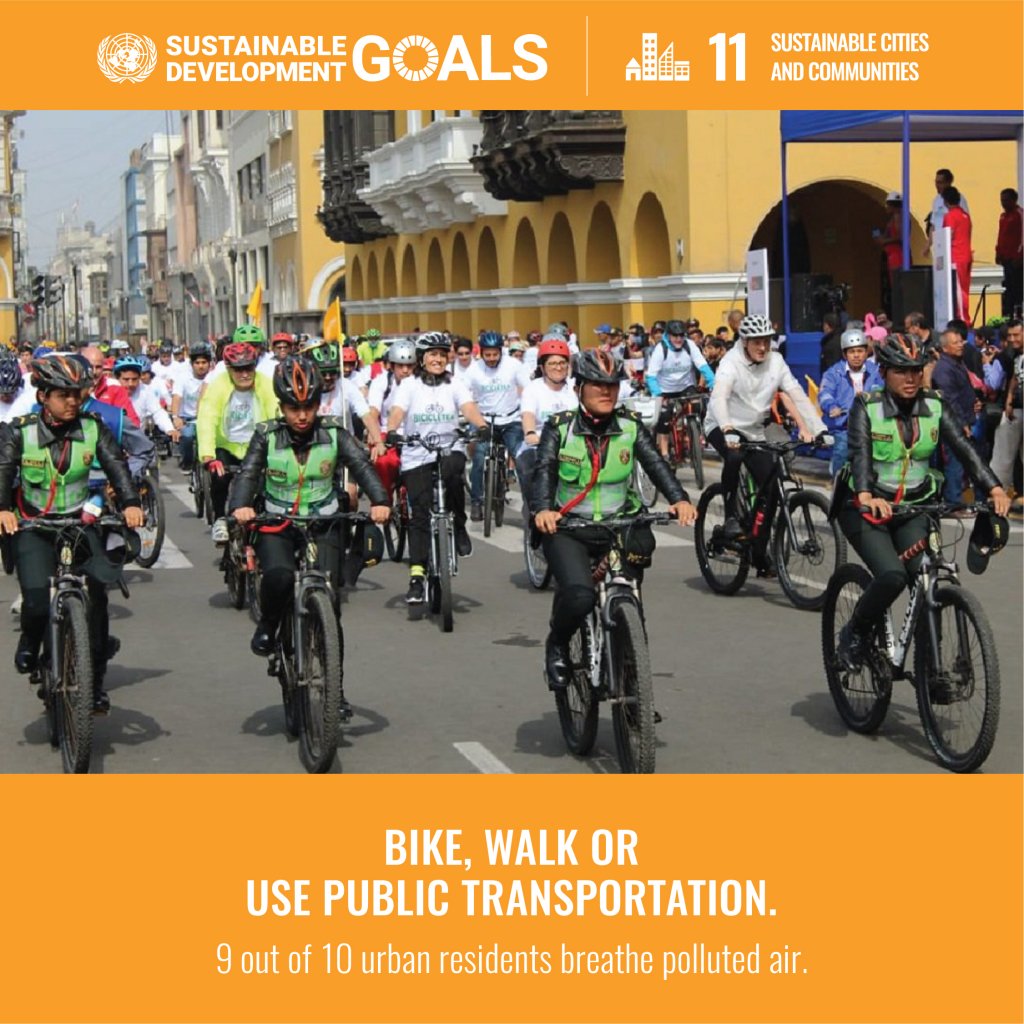
Goal 11: Sustainable Cities and Communities
There needs to be a future in which cities provide opportunities for all, with access to basic services, energy, housing, transportation and more.
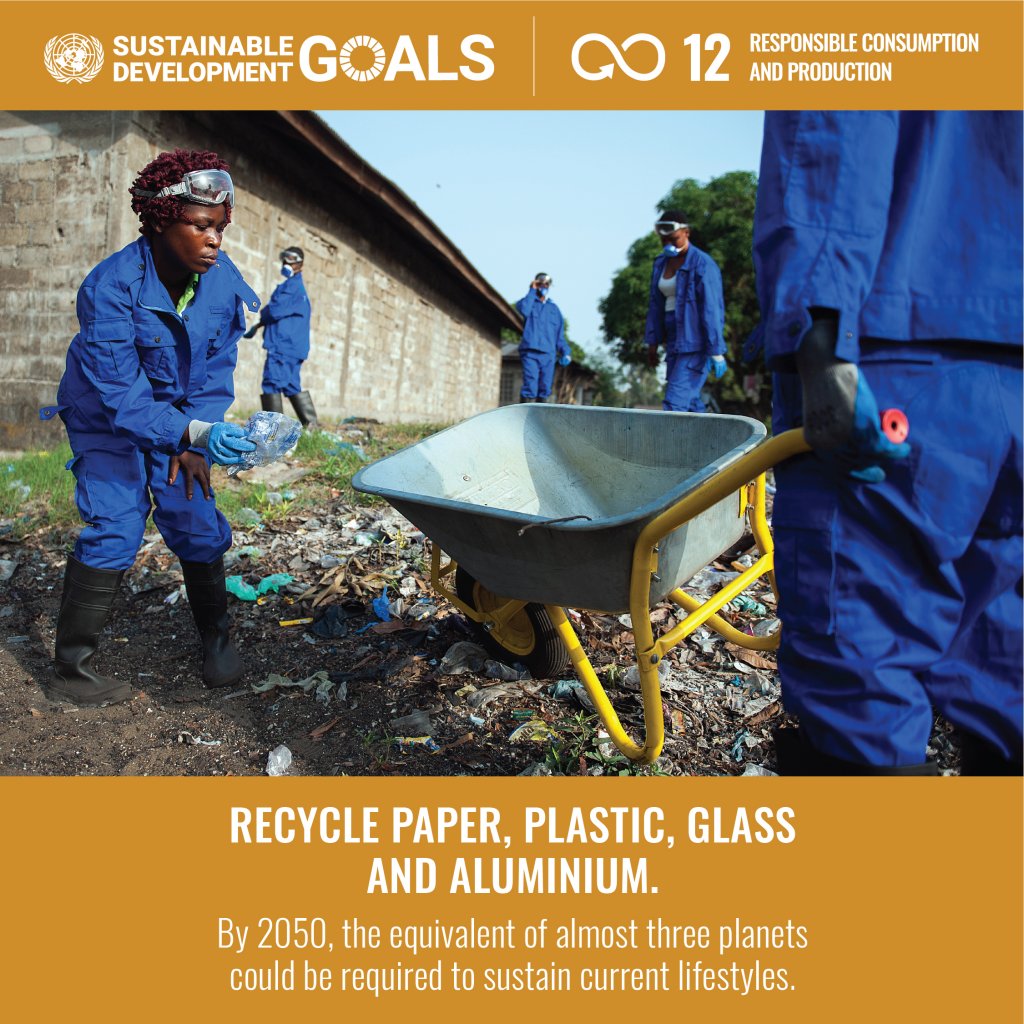
Goal 12: Responsible Consumption and Production
Responsible Production and Consumption
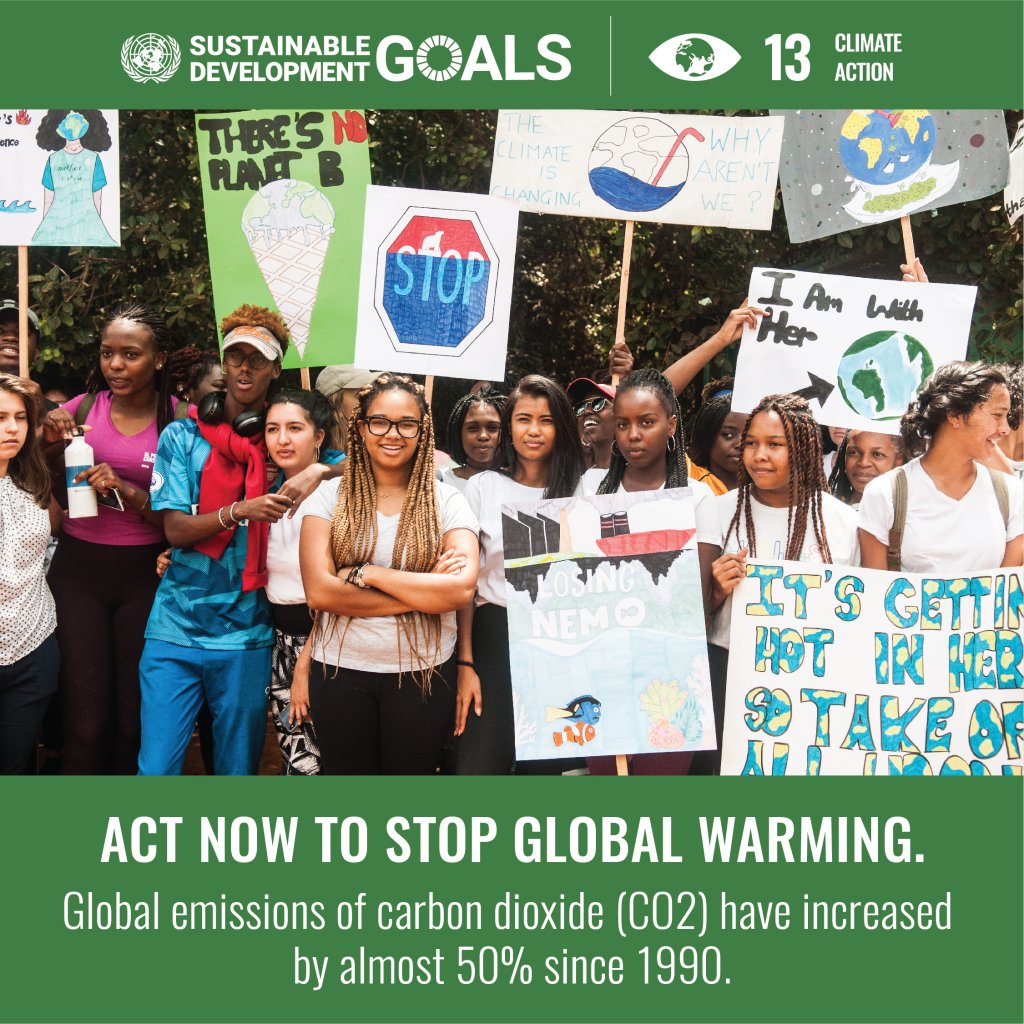
Goal 13: Climate Action
Climate change is a global challenge that affects everyone, everywhere.
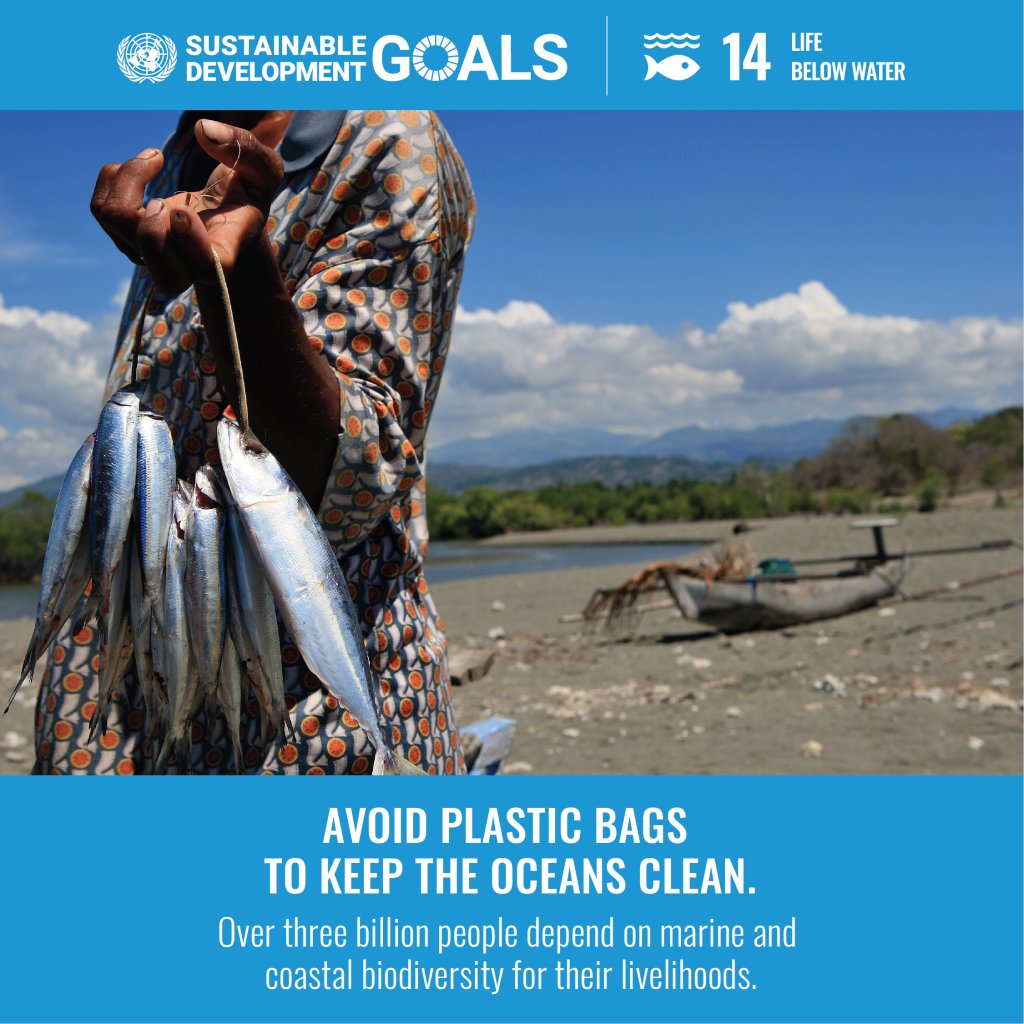
Goal 14: Life Below Water
Careful management of this essential global resource is a key feature of a sustainable future.
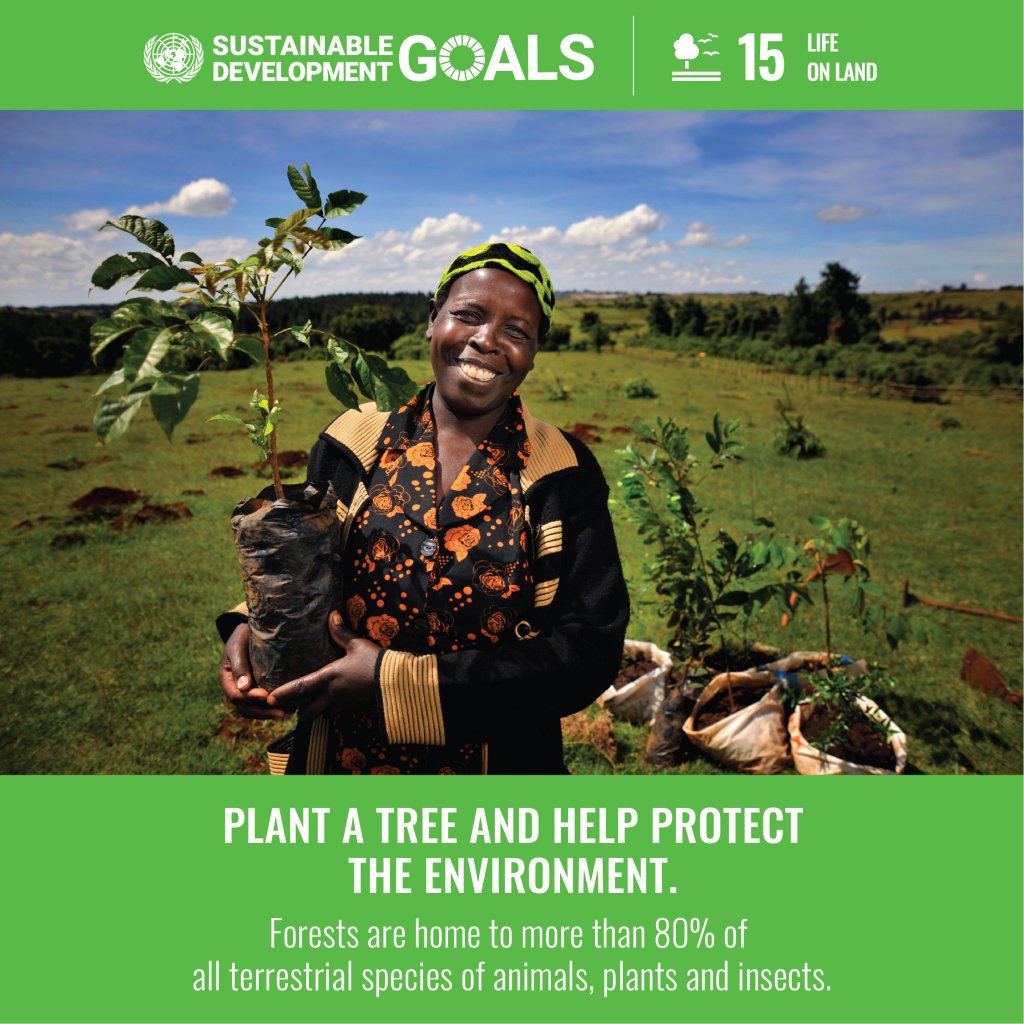
Goal 15: Life on Land
Sustainably manage forests, combat desertification, halt and reverse land degradation, halt biodiversity loss
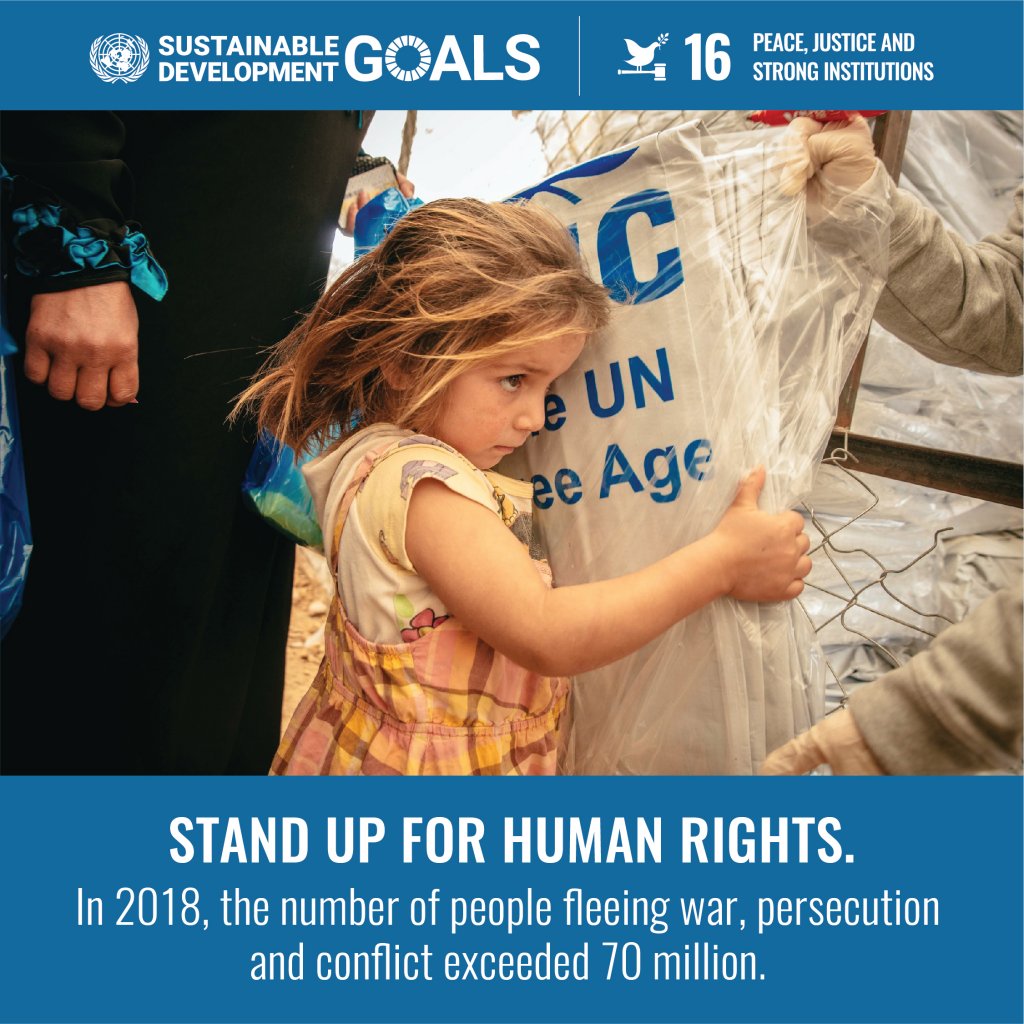
Goal 16: Peace, Justice and Strong Institutions
Access to justice for all, and building effective, accountable institutions at all levels.
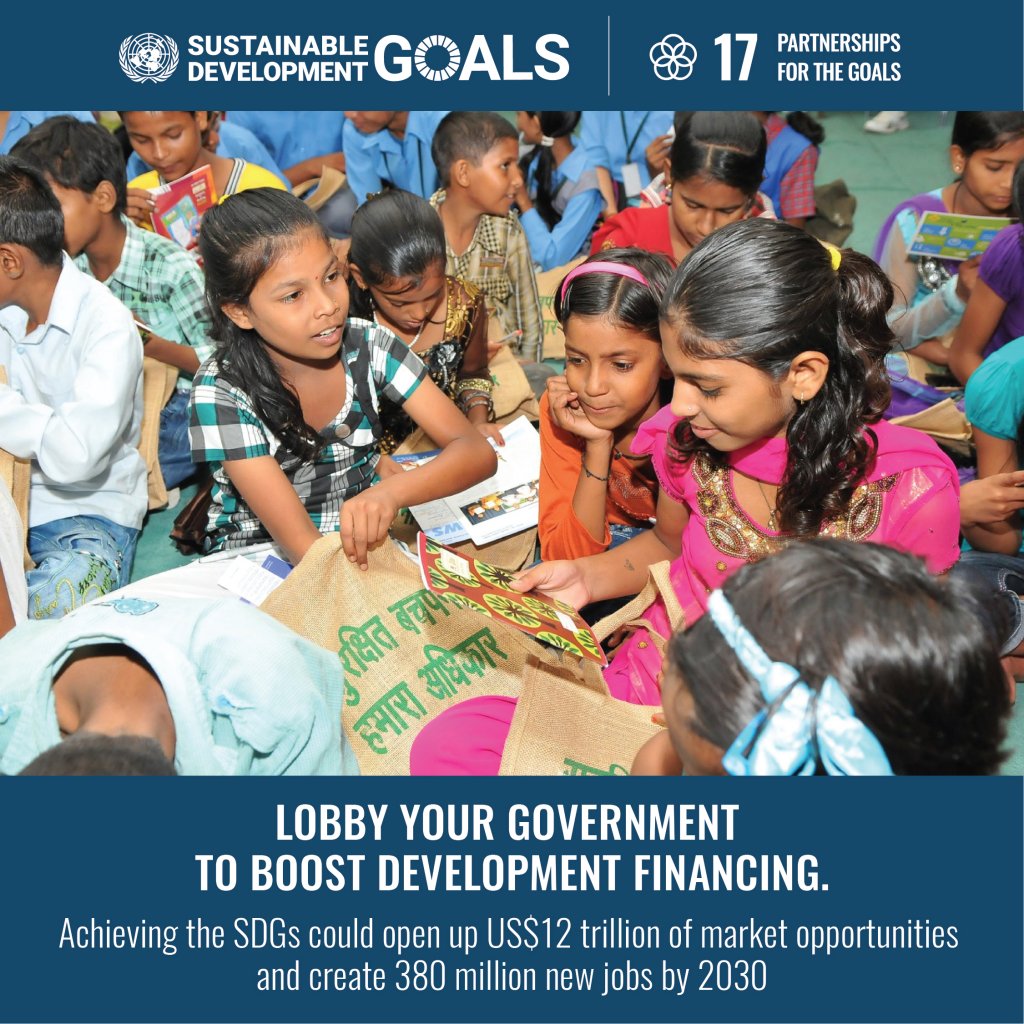
Goal 17: Partnerships
Revitalize the global partnership for sustainable development.
ORIGINAL RESEARCH article
Evaluation of vegetable green logistics in lanling county of china based on dematel-anp-fce model provisionally accepted.

- 1 Qingdao Agricultural University, China
The final, formatted version of the article will be published soon.
Introduction: Due to the problems of greenhouse gas emissions, noise pollution, and vegetable waste pollution during the transportation of vegetables, it is not conducive to the sustainable development of the environment. To mitigate the pollution of the environment during transportation, vegetable green logistics plays a pivotal role in promoting both environmental sustainability and high-quality economic development. Therefore, it is crucial to evaluate the development of vegetable green logistics.Methods: This research builds a DEMATEL-ANP-FCE model to scientifically assess the development of vegetable green logistics in Lanling County. In the first place, the model uses DEMATEL to verify the relationship and degree of influence between the primary indexes. In the second place, the ANP approach with Super Decisions software to determine the weights of the indexes at each level. Lastly, evaluating and scoring vegetable green logistics in Lanling County based on FCE.Results and Discussion: The results of the study show that there is an interaction relationship between the primary evaluation indexes, and its evaluation score is low, the vegetable logistics in Lanling County has not reached the degree of greening. Accordingly, the evaluation results obtained by the DEMATEL-ANP-FCE model in this work are in line with the actual situation of vegetable green logistics in Lanling County, which verifies that the model has good applicability. Moreover, managerial contributions for promoting the development of vegetable green logistics in Lanling County are put forward in response to the evaluation situation. expecting to enhance the greening level of vegetable logistical development and advance agricultural sustainability. Finally, all four questions raised in this paper are well addressed. This study also provides a new perspective and evaluation model for future related research.
Keywords: Lanling County1, vegetables2, green logistics3, DEMATEL-ANP-FCE model4, evaluation5
Received: 08 Mar 2024; Accepted: 26 Apr 2024.
Copyright: © 2024 Wang, Liu, Lu and Cui. This is an open-access article distributed under the terms of the Creative Commons Attribution License (CC BY) . The use, distribution or reproduction in other forums is permitted, provided the original author(s) or licensor are credited and that the original publication in this journal is cited, in accordance with accepted academic practice. No use, distribution or reproduction is permitted which does not comply with these terms.
* Correspondence: Prof. hongzhi Wang, Qingdao Agricultural University, Qingdao, Shandong Province, China Miss. Zhaoli Liu, Qingdao Agricultural University, Qingdao, Shandong Province, China Dr. Hailong Cui, Qingdao Agricultural University, Qingdao, Shandong Province, China
People also looked at

* Acknowledging that the United Nations Framework Convention on Climate Change is the primary international, intergovernmental forum for negotiating the global response to climate change.
Unlocking Sustainable Financing Flows for Environmental and Social Impact in Emerging Markets: Lessons from Southeast Asia
- Google Calendar
- Yahoo! Calendar
- iCal Calendar
- Outlook Calendar
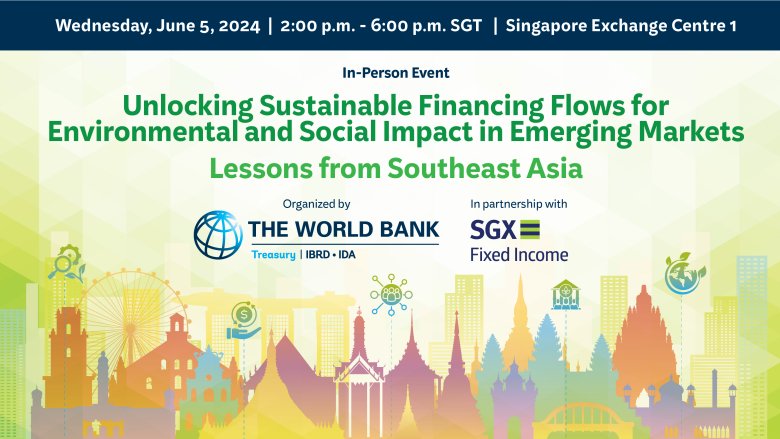
- REGISTRATION
PRELIMINARY AGENDA
The World Bank, in partnership with the Singapore Stock Exchange (SGX), is pleased to invite you to a high-level discussion on “ Unlocking Sustainable Financing Flows for Environmental and Social Impact in Emerging Markets: Lessons from Southeast Asia ” on Wednesday, June 5, 2024, from 2 to 6 p.m. (SGT).
The aim of the discussion is to draw attention to the essential collaboration between public sector borrowers, regulators and policymakers, and the private sector to mobilize private capital for sustainable development.
Please RSVP your participation by completing the registration.
For more information, please contact [email protected]
Please RSVP your attendance by completing the registration using the link below, using desktop only .
Registration link: https://ebizprd.worldbank.org/event/login
[ebizprd.worldbank.org]
Username: ESG2024 Password (case sensitive): Singapore2024
A confirmation email will be sent to you after completing the registration. Further details on the agenda and logistics will follow.
For more information or to register manually, contact Amira Amat:
Email: [email protected]
This site uses cookies to optimize functionality and give you the best possible experience. If you continue to navigate this website beyond this page, cookies will be placed on your browser. To learn more about cookies, click here .

IMAGES
VIDEO
COMMENTS
Essay on Sustainable Development: Samples in 250, 300 and 500 Words. On 3rd August 2023, the Indian Government released its Net zero emissions target policy to reduce its carbon footprints. To achieve the sustainable development goals (SDG), as specified by the UN, India is determined for its long-term low-carbon development strategy.
500 Words Essay on Sustainable Development. Sustainable development is basically an action plan which helps us to achieve sustainability in any activity which makes use of the resource. Moreover, it also demands immediate and intergenerational replication. Through essay on sustainable development, we will help you understand the concept and its ...
The term "sustainable development" is often used in business, government, and non-profit spaces to refer to the processes and pathways required to balance economic growth, environmental stewardship, and social inclusion. Sustainability is considered a paradigm for thinking about balancing environmental, economic, and social needs for the ...
500+ Words Essay on Sustainable Development. Sustainable development is a central concept. It is a way of understanding the world and a method for solving global problems. The world population continues to rise rapidly. This increasing population needs basic essential things for their survival such as food, safe water, health care and shelter.
The intellectual underpinnings of sustainable development lie in modern natural resource management, the 20th-century conservation and environmentalism movements, and progressive views of economic development.The first principles of what later became known as sustainable development were laid out at the 1972 United Nations Conference on the Human Environment, also called the Stockholm Conference.
In short, the 17 SDGs are: Goal 1: No Poverty: End poverty in all its forms everywhere. Goal 2: Zero Hunger: End hunger, achieve food security and improved nutrition and promote sustainable agriculture. Goal 3: Good Health and Well-being: Ensure healthy lives and promote well-being for all at all ages.
Sustainable development is a process that creates growth and progress through the addition of physical, economic, environmental, and social components to improve quality of life without damaging the resources of the environment. Simply put, sustainable development is a way for people to use resources without the resources running out 3.
sustainable development as "development that meets the needs of the present without compromising the ability of future generations to meet their own needs" (United Nations General ... Discussion on the Coase theorem and the Porter and van der Linde hypothesis. Ecological Economics, 209-225. Cooper, P. J., & Vargas, M. (2004).
To fight the global problems of humanity, the United Nations has adopted 17 Sustainable Development Goals (SDGs). To achieve these goals, it is necessary that future decision-makers and ...
The environment underlies each of those goals - from eliminating hunger to reducing inequalities to building sustainable communities around the world. UNEP is committed to working with all concerned parties to support the achievement of the 17 UN Sustainable Development Goals (SDGs). We promote environmental sustainability as a crucial enabling factor in implementing the SDGs and ensuring ...
Build resilient infrastructure, promote inclusive and sustainable industrialization and foster innovation. The manufacturing industry's recovery from COVID-19 is incomplete and uneven. Global ...
THE SUSTAINABLE DEVELOPMENT GOALS 2 About this essay 3 Executive summary 5 Introduction 7 Chapter 1: The dividends 11 Chapter 2: The challenges 14 Chapter 3: ... Indeed, the Paris Agreement, the 2030 Agenda for Sustainable Development—which supports the Sustainable Developments Goals (SDGs) developed by UN member states—the New Urban Agenda ...
The essay also highlights key strategies and policies that can facilitate the transition towards a more sustainable and resilient future. By embracing sustainable development principles, societies can create a harmonious relationship between ... Sustainable development offers a framework for reducing greenhouse gas emissions, promoting ...
This paper explores the empirical links between sustainable development and human well-being. Sustainable development is a broad and easily misunderstood concept 1, but the term first entered ...
Discussion Paper - Governance for Sustainable Development. There are now widely accepted arguments that governance is of high relevance to the post-2015 development agenda: effective governance institutions and systems that are responsive to public needs deliver essential services and promote inclusive growth, while inclusive political ...
High-level political forum on sustainable development Convened under the auspices of the Economic and Social Council 7-16 July 2020 Item 2 of the provisional agenda* Accelerated action and transformative pathways: realizing the decade of action and delivery for sustainable development Discussion papers on the theme of the high-level political
The UNECE series of Discussion Papers is intended to make available to a wider audience papers on matters of topical interest that have been prepared by the staff of the ... 8 For a more detailed conceptual discussion of sustainable development, refer to UNECE (2009) Measuring Sustainable Development , pp.18-24.
The Agenda 2030 with its 17 Sustainable Development Goals (SDGs) provides the framework that all United Nations (UN) member states have pledged to fulfill. The achievement of this agenda crucially ...
The concept of "sustainable development" is hinged on three interdependent and mutually reinforcing pillars: economic development, social development, and environmental protection. It calls on human societies to meet their needs without compromising the ability of future generations to meet their own.3 The idea dates
Sustainable development requires six central capacities. Sustainable development is an organizing principle that aims to meet human development goals while also enabling natural systems to provide necessary natural resources and ecosystem services to humans. The desired result is a society where living conditions and resources meet human needs without undermining the planetary integrity and ...
Watch on. The Sustainable Development Goals are the blueprint to achieve a better and more sustainable future for all. They address the global challenges we face, including those related to ...
Ans:. Sustainable development refers to a mode of human development in which resource use aims to meet human needs while preserving the environment so that these needs can be met not only in the present, but also for generations to come. The term 'sustainable development ' was used by the Brundtland Commission which coined what has become the ...
1.1. Uneven regional development. Applied at the regional level, 'Transit Oriented Development' (TOD) is commonly considered a planning strategy that facilitates sustainable transport systems (Hrelja et al., Citation 2020; Nigro et al., Citation 2019) and increased access to jobs and workers through shorter travel times (Deboosere et al., Citation 2018).
Introduction: Due to the problems of greenhouse gas emissions, noise pollution, and vegetable waste pollution during the transportation of vegetables, it is not conducive to the sustainable development of the environment. To mitigate the pollution of the environment during transportation, vegetable green logistics plays a pivotal role in promoting both environmental sustainability and high ...
1.1. By 2030, eradicate extreme poverty for all people everywhere, currently measured as people living on less than $1.25 a day. 1.2. By 2030, reduce at least by half the proportion of men, women and children of all ages living in poverty in all its dimensions according to national definitions. 1.3.
The World Bank is pleased to invite you to an in-person event discussion on "Unlocking Sustainable Financing Flows for Environmental and Social Impact in Emerging Markets: Lessons from Southeast Asia" on Wednesday, June 5, 2024, from 2 to 6 p.m., SGT. This event is supported by the Singapore Stock Exchange (SGX) and will take place at the SGX auditorium. The aim of this high-level panel ...
The global economy has shown remarkable resilience, and appears headed for a soft landing. But buffers have been eroded, growth prospects are lackluster, and vulnerable countries are at risk of falling further behind. While inflation has fallen, it remains above target in many countries. Against this background, the key policy priorities are to: (i) rebuild buffers; (ii) revive medium-term ...